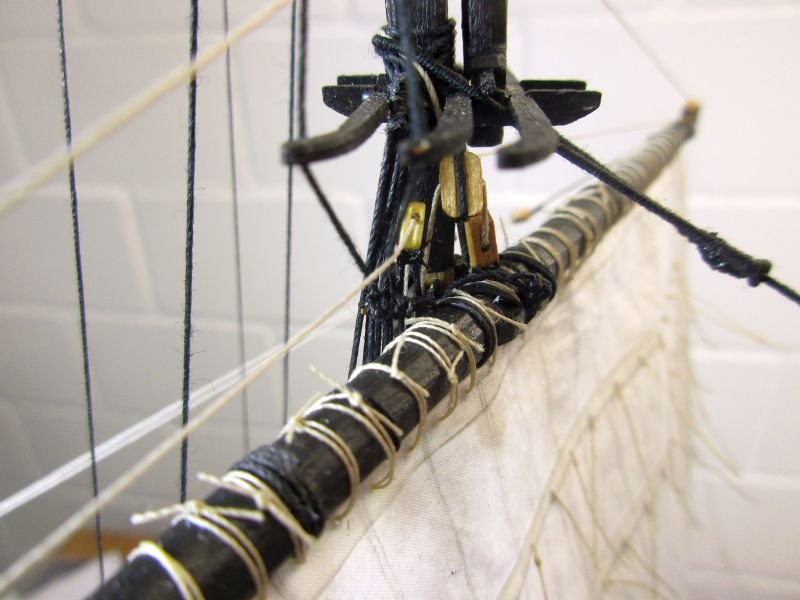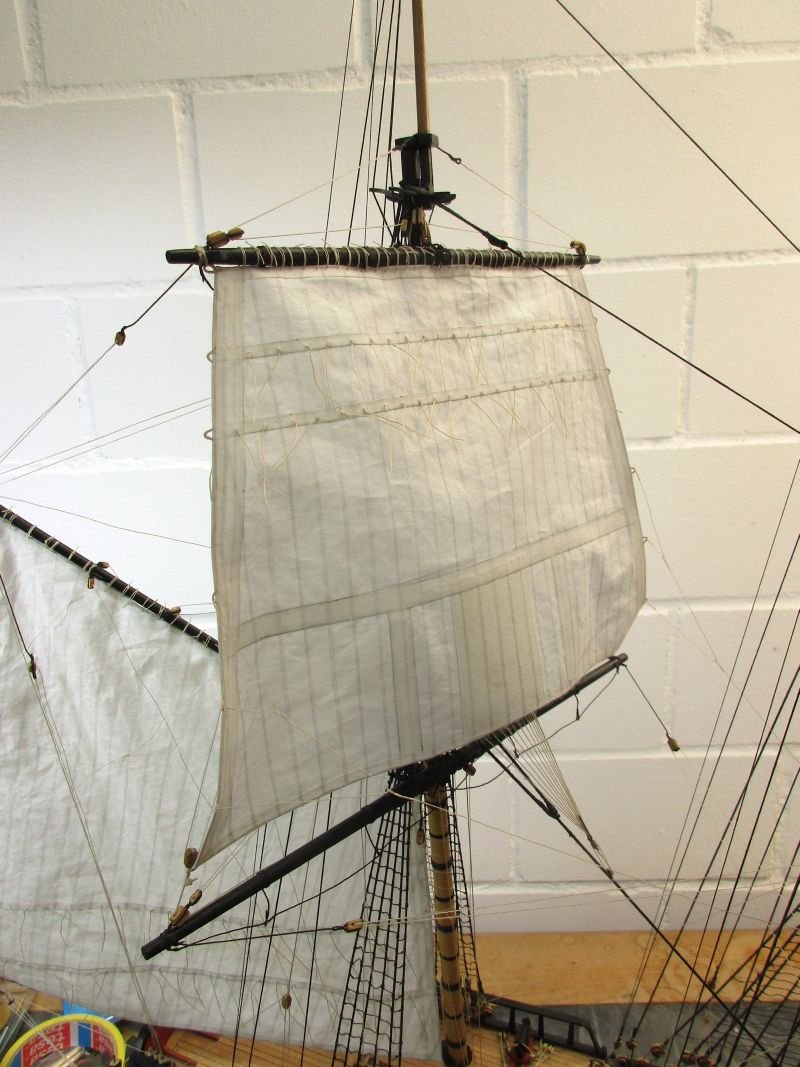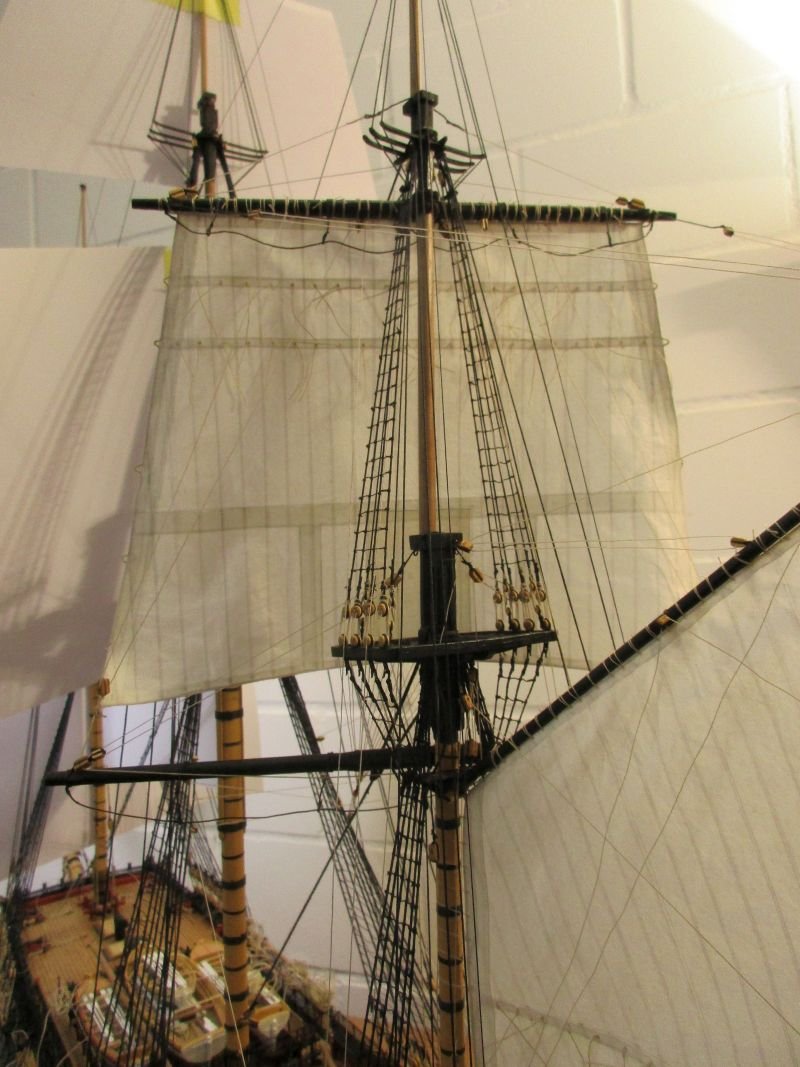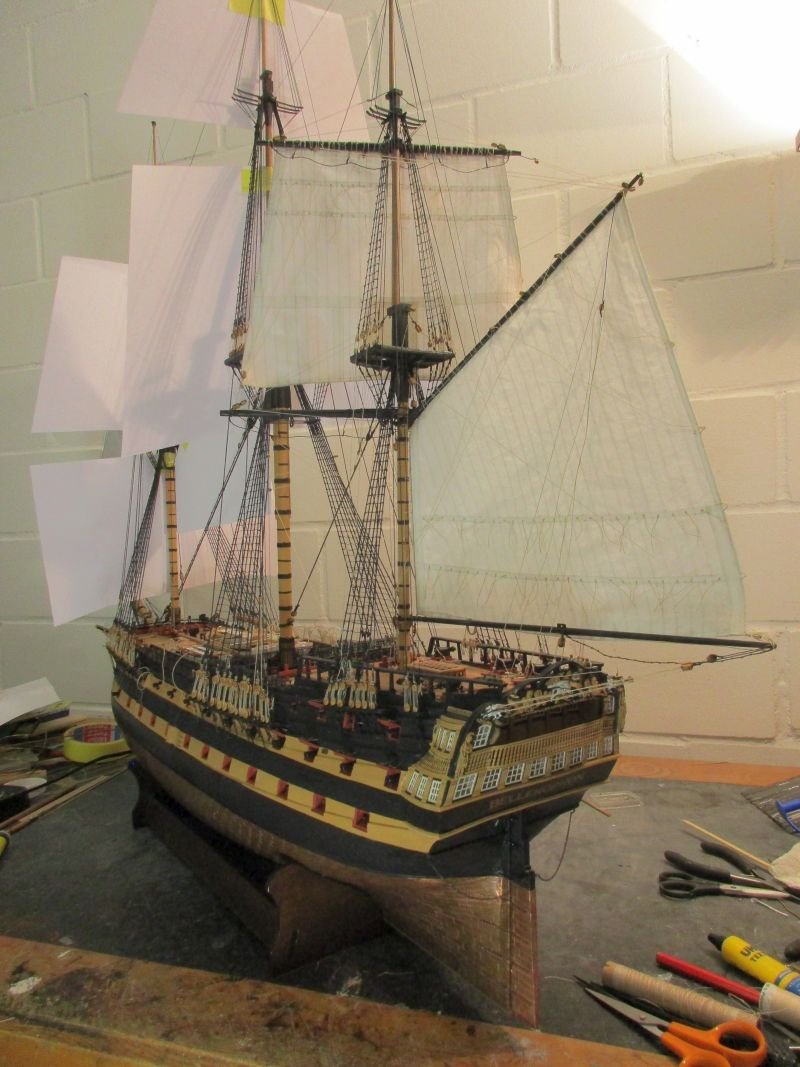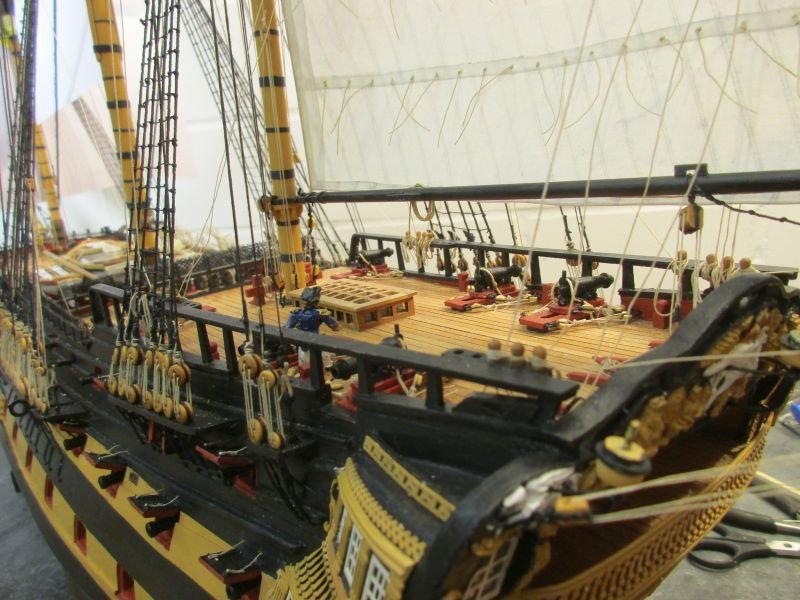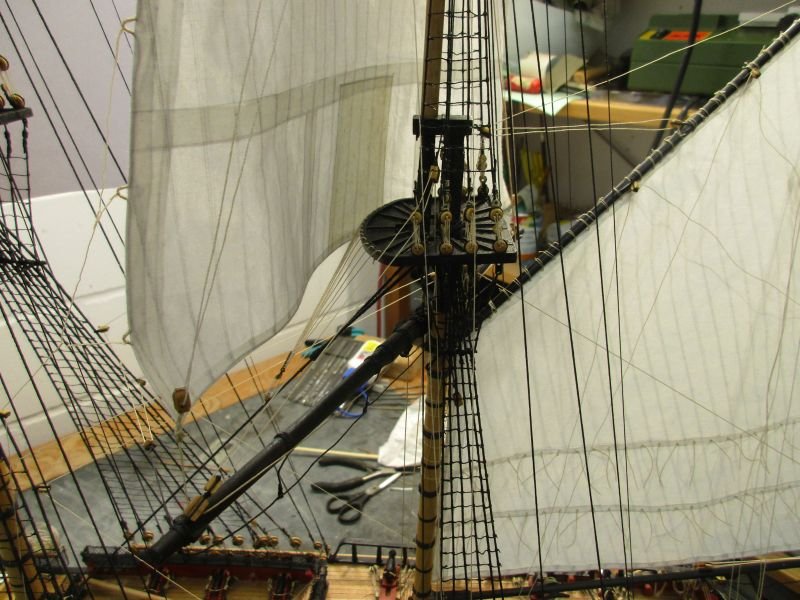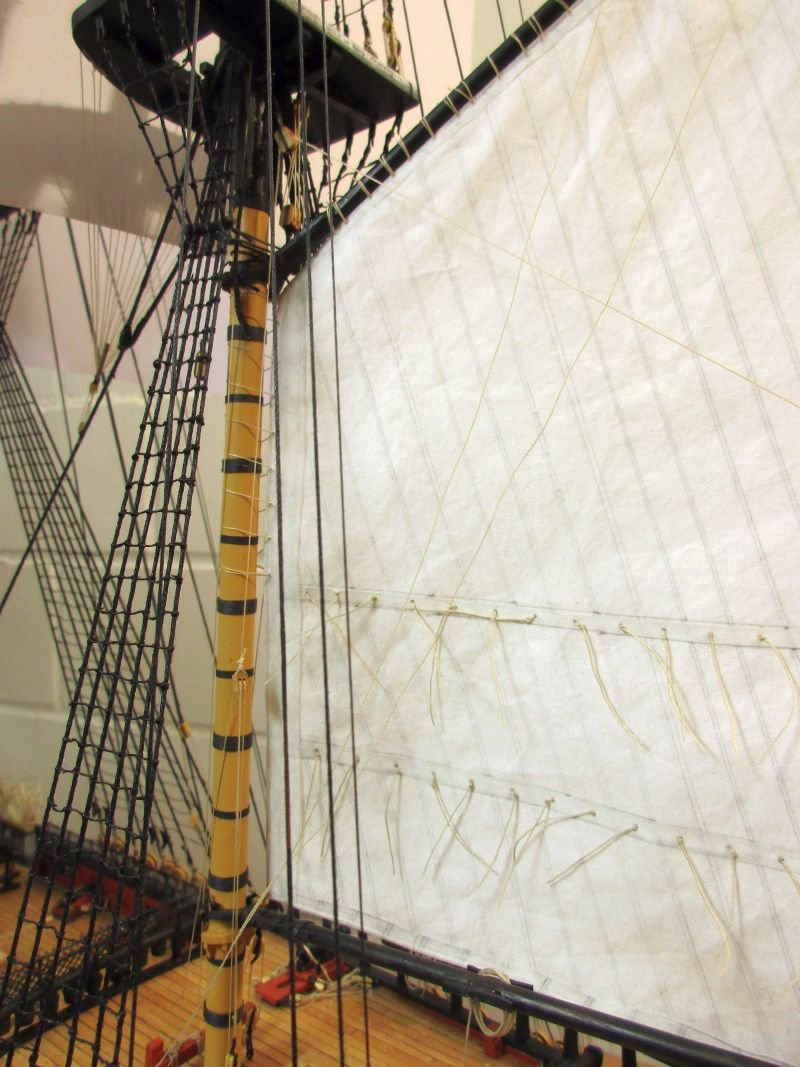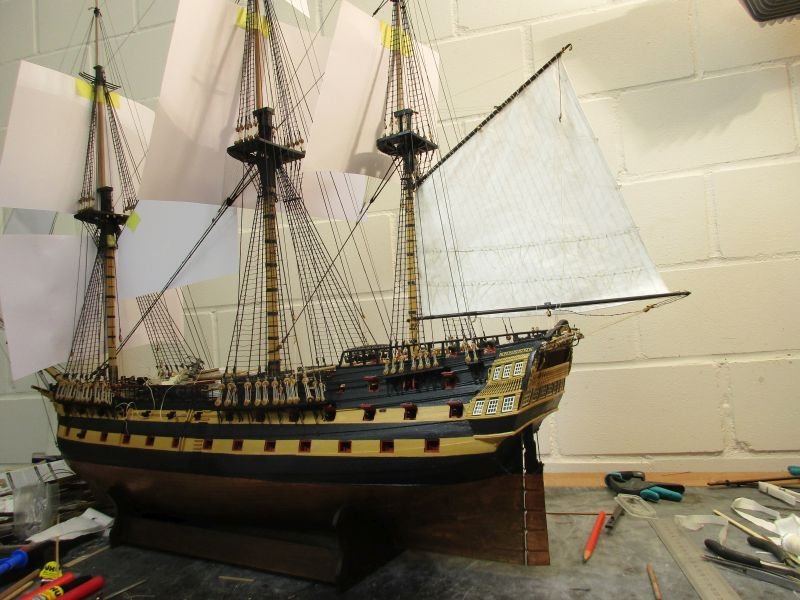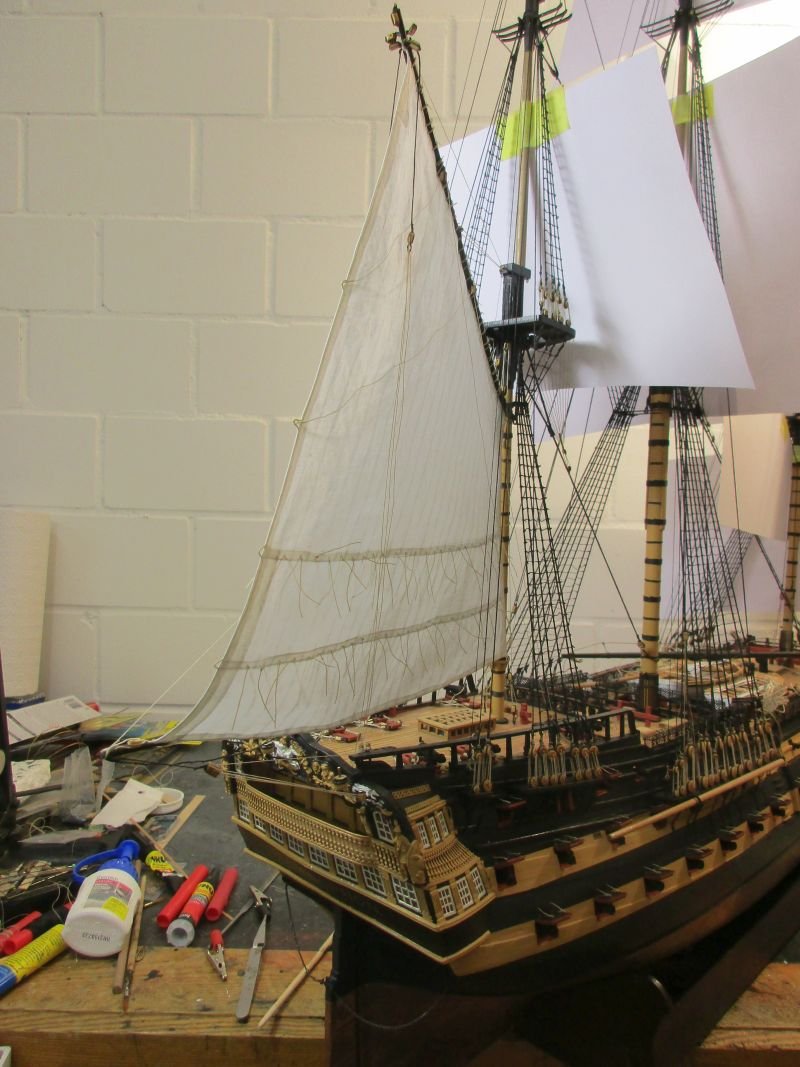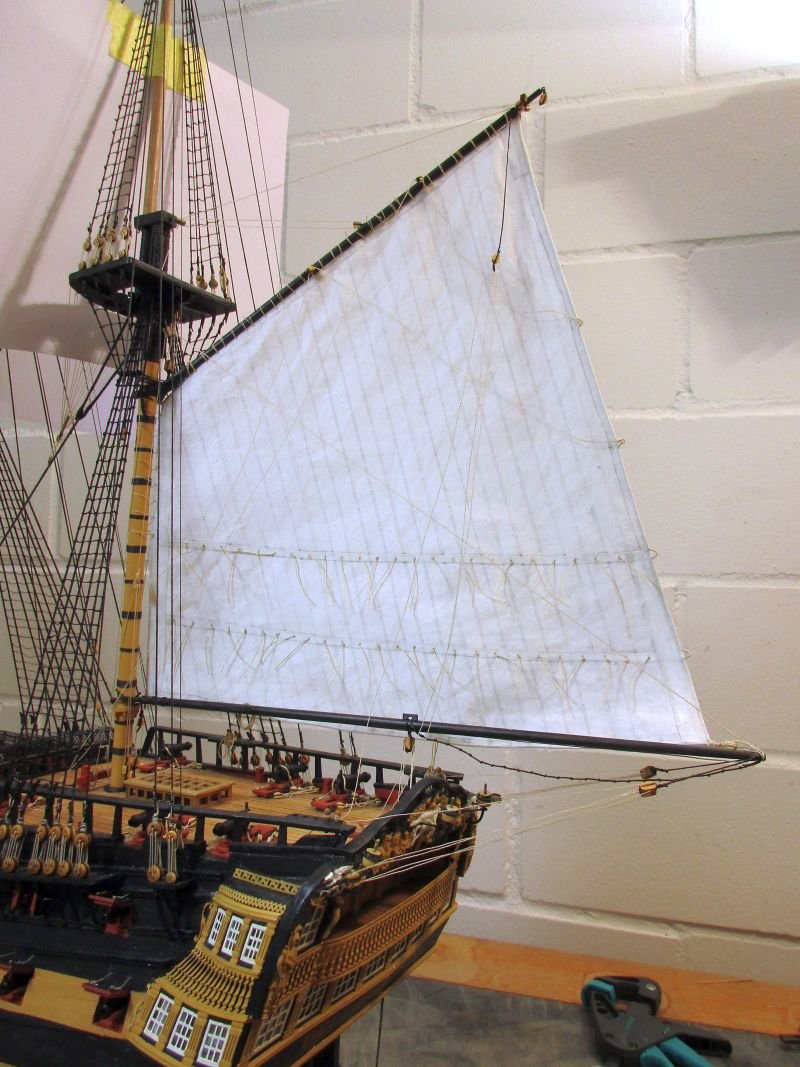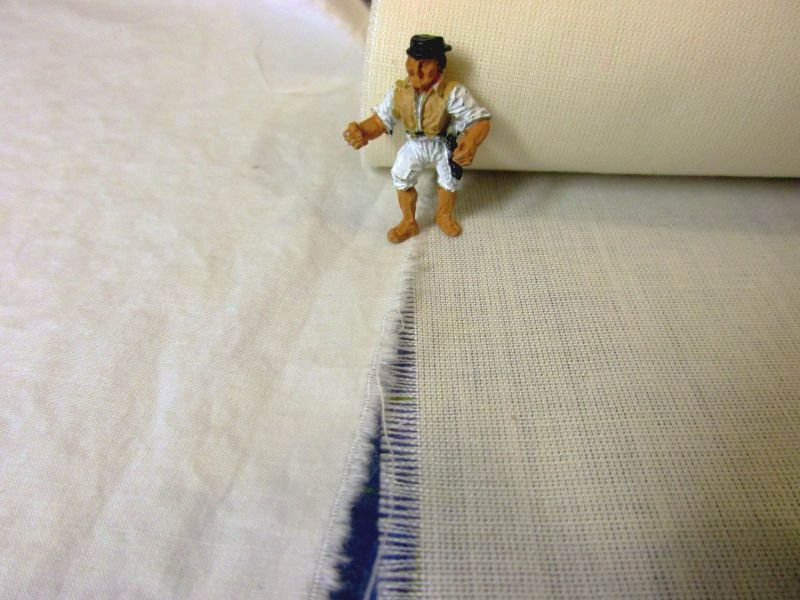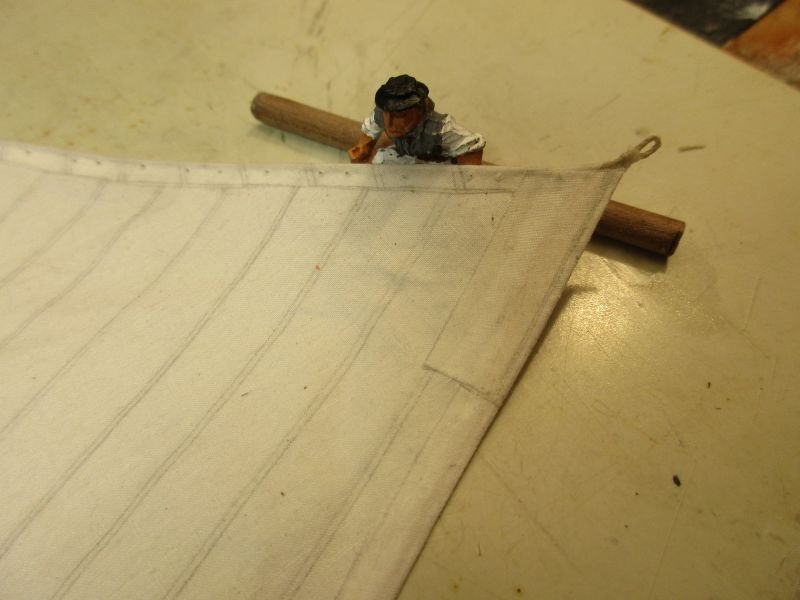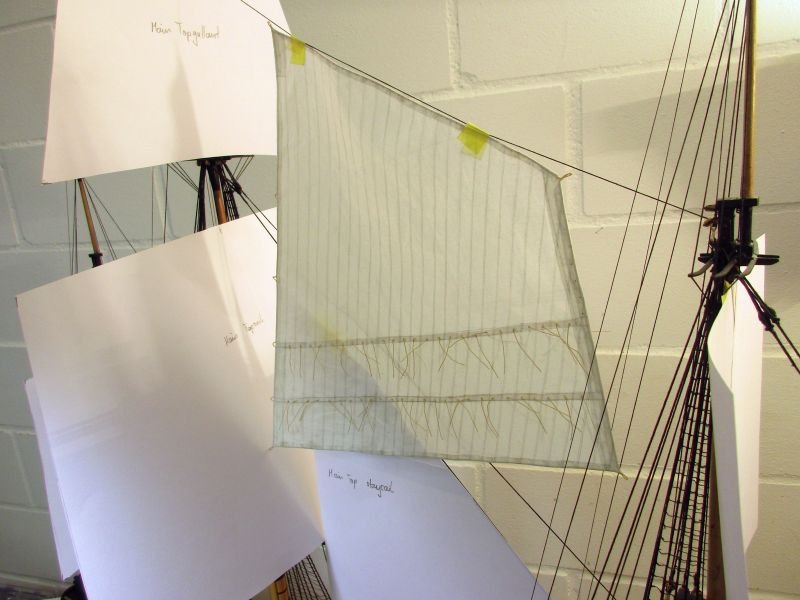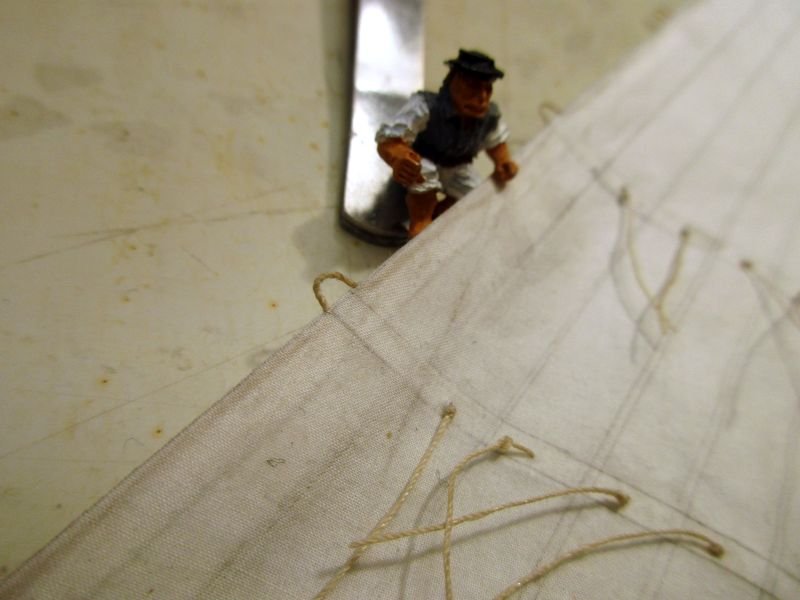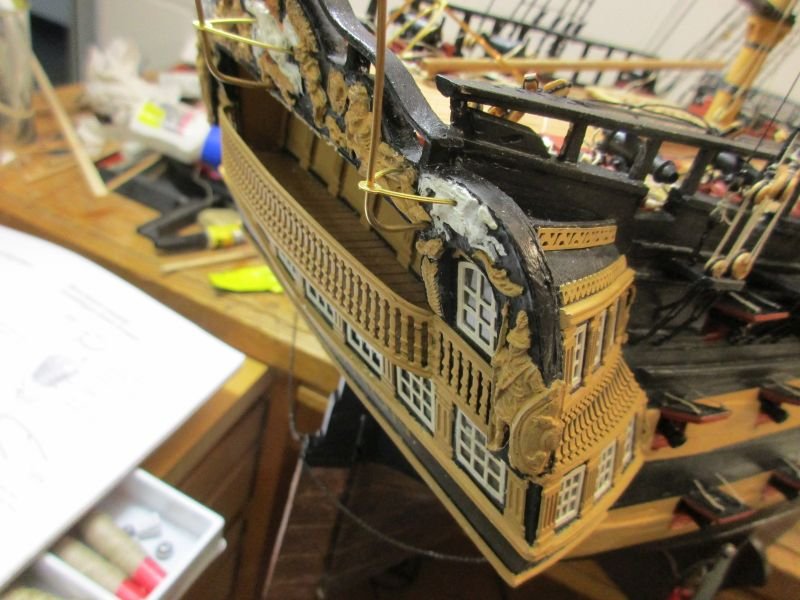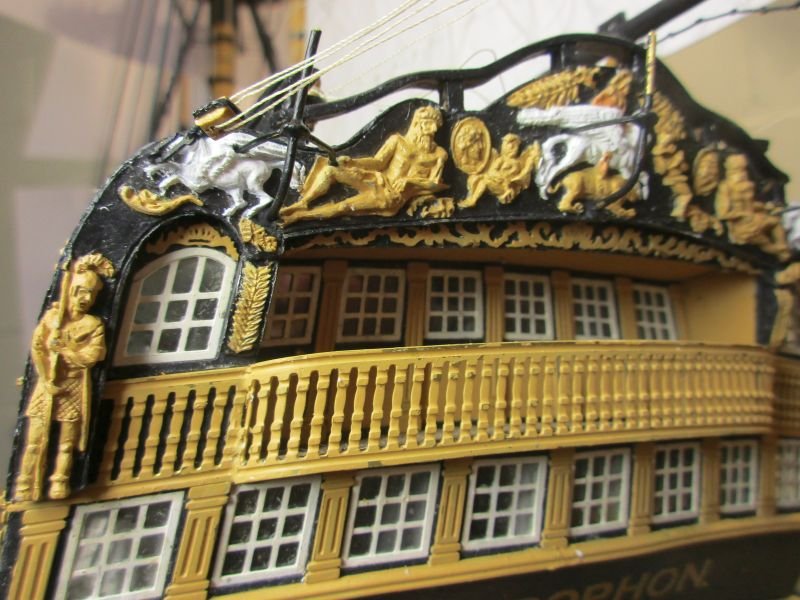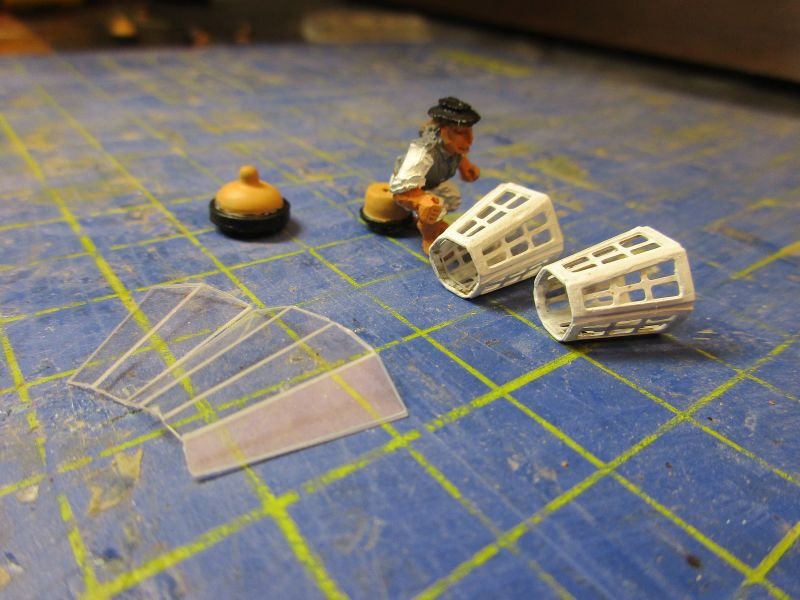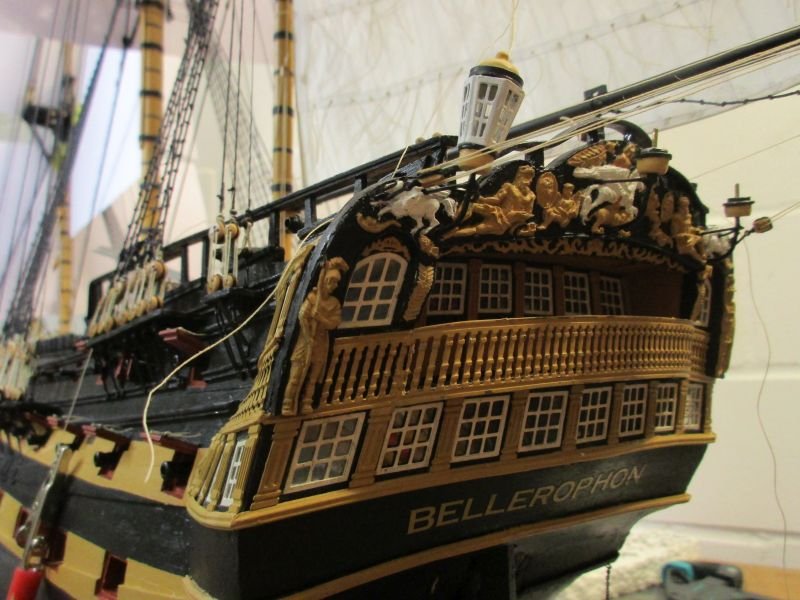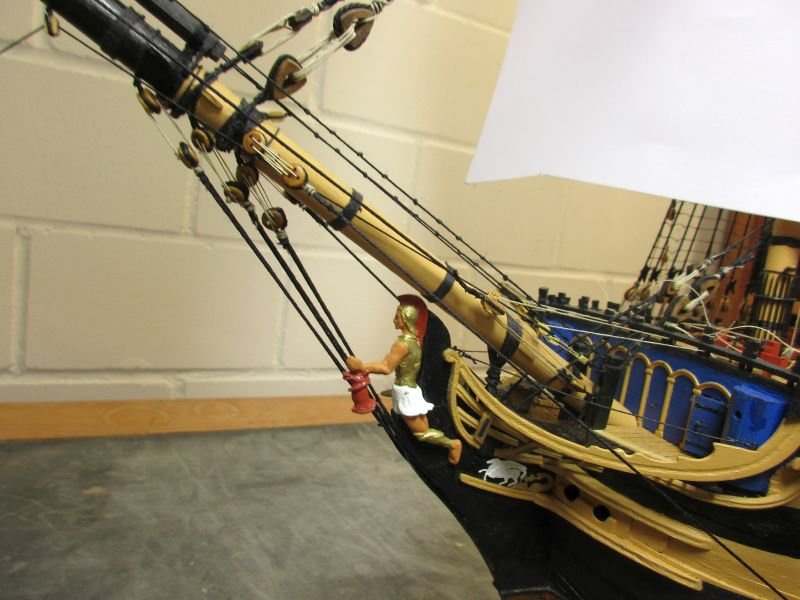-
Posts
1,016 -
Joined
-
Last visited
Content Type
Profiles
Forums
Gallery
Events
Everything posted by flyer
-
main topsail yard and sail Sail making and -hoisting slowly became not exactly fun, but an acceptable routine. Or so I thought, until I spotted 2 broken crosstrees on the fore mast. Turning the model to get access to both sides is tricky but necessarily quite often done. It must unobserved had happened during such a maneuver. This was not the first similar accident and I find that many - especially newer kits - have rather flimsy crosstrees, likely to break. I wonder if it wouldn't be more sensible to provide them as an photo etched metal part. Anyway, I carefully drilled 0,5 mm holes lengthwise into the broken parts and the trestletrees , inserted very stiff 0,4mm copper wire as internal splints and glued with epoxy. So far it holds. The main topsail probably is the largest and most complicated sail but routine helped in making it. Putting it up according to the kit's instructions went fine. I rather like the look of those sails and of my Bellerophon. result of an unwatched accident after some plastic surgery finished sail ready for the yard views of the main top sail the main bitts look properly crowded sailing slowly away...
- 366 replies
-
- bellerophon
- victory models
-
(and 2 more)
Tagged with:
-
While I see many excellent examples of sails in this discussion I would suggest also to give some thoughts to how to set them: Perhaps I'm a bit fussy - especially for a landlubber - but after all that work we put into building a perfect model I find it a pity to see it set up in an altogether unrealistic stance. In my opinion it's best to imagine the model in a concrete situation to avoid an unrealistic setup: What amount of wind is there and from what direction does it blow? As the best point of sailing for most square riggers would be with a wind from an aft quarter you would see her most of the time sailing with braced yards and only a selected amount of sails set. A squarerigger with exactly squared yards and all sails set and filled with wind from dead astern therefore looks a bit unrealistic as the aft sails would partly or fully becalm those on the main and fore mast. Only mizzen sails and some on the mainmast would draw. Also filled square sails set on exactly squared yards plus equally filled fore and aft sails set along the centerline seem a contradiction. And with sails fully filled, the ship would hardly lay on an even keel. On the other hand if you think about some light winds you could set as many sails as you like. Just keep in mind that with fore and aft sails set the yards again most probably would be braced. All sails set and all yards braced square could only mean that you are taking advantage of the present calm to dry all your 'laundry'. Which then should hang limp. For my sails I prefer a very, very light cotton with penciled on cloth's seams and glued hems, reef bands and linings. The bolt rope is glued into the hem and - in my opinion - looks even better than one attached with almost unavoidable oversized stitching. I use a special textile glue. This method is the result of several articles found here on MSW. Some silkspan sails do look terrific (e.g. those B.E. made) but others still seem a bit papery and I guess handling of that stuff isn't as easy as handling some good old-fashioned cotton. But however the sails look like - I'm a great fan of any sails on a model ship. The simply perfect the picture. Cheers Peter
-
Hi Ian Thanks, but there is more than one reason to lower the image definition before posting the pictures... I'm looking forward to see your spanker - in high definition. Cheers Peter
- 366 replies
-
- bellerophon
- victory models
-
(and 2 more)
Tagged with:
-
Hi BE Thanks a lot. I'm using a rather old Cannon Ixus. The colours and brightness sometimes need reworking but the camera's lenses are still superior to anything smartphones offer. Cheers Peter
- 366 replies
-
- bellerophon
- victory models
-
(and 2 more)
Tagged with:
-

Occre Diana (Spanish frigate 1792), low quarter gallery windows?
flyer replied to Esap's topic in Wood ship model kits
I always liked the look of OCCRE's Diana - except for the fact, that looking from behind she seems to lose her trousers. As Mark said, you would have to remodel the complete stern as well. Perhaps you would consider to build Amati's Fly? She cost just a few pounds more, builds to a model of about the same dimensions, has three masts as well, is in a more convenient scale and is much better researched. Regards Peter -
Meriadoc and Alan, Yes, landlubber me was confusing some nautical terms - once again I feel a certain kinship with Stephen Maturin. Meriadoc, what I meant was sling. The log is now corrected. Alan, you are right, of course, about the tie. On Bellerophon however I think I installed jeers. As I understand James Lees they complemented and finally replaced the ties in the 17th century. Thank you very much and Happy Holidays! Peter
- 366 replies
-
- bellerophon
- victory models
-
(and 2 more)
Tagged with:
-
Thank you all for the likes and the much appreciated feedback. Alan, you should be aware that looking closer entails the risk of seeing a lot of botches and flaws.🧐 Merry Christmas and a Happy New Year! Peter
- 366 replies
-
- bellerophon
- victory models
-
(and 2 more)
Tagged with:
-
main yard and course The main course's area was also reduced by about 30% and the simplified sail then bent to the yard. (Easily said - but I had to knot about 90 robands.) Buntlines, bowlines and clue lines were added and the sail then furled. It sits perhaps not high enough on the forward side of the yard, but I didn't want to cover the studding sail booms. Setting up the yard was started with the sling. Then again followed a process of balancing lifts, braces, jeers and trusses to get a horizontal yard, braced by about 20° and with no slack in the sling. How to set up lifts caused a bit of head scratching: With yards squared it is obvious how to lead them in order not to conflict the standing rigging. But with the yard braced you will have to set them up the same way and they will not run free anymore but bend around the standing rigging. And of course the yard itself presses onto the foremost shroud on lee side. Letting loose the truss falls a bit helps here. Then I had to lead all the lines through the correct blocks to the appropriate belaying points. Some I had to improvise, such as those for the yard tackles and its gear. For the buntlines I changed the run under the main top. I had installed additional blocks and each runs now through two blocks in succession, similar to the plans for the fore course buntlines, and so clear the yard. Now I only had to fix and coil a zillion rope ends and voila - another tiny step towards completion was done. Sometime during that step, when I had enough of lace making, I finished the stern lanterns. main yard from above - the reduced sail area is marked in the plan below it yard seen from below sling, jeers and lifts as well as buntlines visible below the maintop detail with truss main yard from above - kink in lift due to the foremost shroud visible Do you see the sailor in the maintop? Those ships were huge! foot of the main mast with bitts quite full view along the deck stern lanterns in place she's taking shape
- 366 replies
-
- bellerophon
- victory models
-
(and 2 more)
Tagged with:
-
Hi Björn That's what I did. Not fully trusting the slots in the structure, I checked all mastheads for height over deck according to the plans. Cheers Peter
- 366 replies
-
- bellerophon
- victory models
-
(and 2 more)
Tagged with:
-
Hi Nils Just found your album of the pilot schooner. Again an outstanding build! (But who would expect less?) I really like that every one of your beautiful models clearly bears your trademark, setting them apart from the rest. Cheers Peter
- 180 replies
-
- pilot boat
- Elbe 5
-
(and 3 more)
Tagged with:
-
Hi Alan You are on a most interesting journey - thanks for taking us along. Watching you struggle with the correct form of those stern timbers lets me appreciate how complicated the work of those shipwrights really was. I guess they had to try, correct, try again and correct again their timbers as well. But in scale 1/1 that was some heavy load to shift each time. On the other hand they could make corrections with the timber in place - where you have not enough room to work. It's a pleasure to watch your Bellerophon taking form. Peter
-
A wonderful side project! I love the details. And Chris Watton's figures really are bring a model to live. Peter
- 27 replies
-
- galley stove
- Syren Ship Model Company
-
(and 1 more)
Tagged with:
-
Thank you, Alan. To reduce the sail area this way was just a random idea which for once seems to work. I'm afraid I'm unable to express the real amount of fun I had setting up all those lines - there might be readers of minor age. Frankly, it wasn't too bad but a bit tedious. After seeing my photos I had to start - as it very often is the case - to rework the sail stowing. The starboard clew looked to loose and was tightened. Thanks again for the positive feedback. It's always a big motivation. Peter
- 366 replies
-
- bellerophon
- victory models
-
(and 2 more)
Tagged with:
-
mizzen topgallant yard and sail According to my sail plan the mizzen topgallant sail is furled. Zu Mondfeld recommends to reduce the area of furled sails by about one third - to get a smaller coil of sailcloth. This I followed and made a smaller sail, however with the same width of head and foot. Seams were penciled on and the hem was glued as usual, but no reef bands ore linings were put on. Also the boltrope covers only the head and the clews to further reduce the bulk of the furled sail. The sail was then bent to the yard and tie, clew lines and simplified bowlines added. Now the sail was furled as tight as possible - but no harbor stow fit for an admirals inspection - and bent to the yard. The clews are hanging down on the forward side as seen on various illustrations. The yard was put up with its tie and fixed to the mast with a simple truss parrel according to Lees. A whole arrangement with parrel ropes, rips and trucks - as shown on the kits plans - seems to me too bulky for such a light spar and out of proportions. Now lifts, braces and sheets were installed and balanced against each other to have the yard horizontal and braced parallel to the topsail yard and the crossjack. The clew lines were set up to fix the clews against the pull of the sheets. Each pull on one line of course sets up the balance and requires adjusting of several other lines - a heartwarming procedure which gives a lot of joy and generates a peaceful mind. (...) The bowlines were set rather taut and help to fix the position of the yard. Not all belaying points were marked on the plan and I had to change a few and find some new ones. As far as possible I used Lees as a help but sometimes I differed and looked for a simple and yet logical solution. Lines were only provisionally belayed until all lines and forces were balanced (or nearly so) and then fixed with diluted white glue and the ends coiled up. Now the mizzen mast is fully rigged except for the flag line and the next step awaits me - the mighty main yard with its furled mainsail and as an extra the stowed yard tackles. reduced sail marked in blue on the plan first side of sail marked on cloth sail with lines attached - ready to furl yard with furled sail, ready to hoist topgallant yard in position mizzen mast with all spars on the poop deck gives now a properly busy impression
- 366 replies
-
- bellerophon
- victory models
-
(and 2 more)
Tagged with:
-
the new crew from Vanguard Models After seeing Chris Wattons crew figures I had to try and hire a few of them. In my opinion, they surpass all expectations. The lively and individual stance of the figures makes them come alive. The details, such as faces with individual features, are just unbelievable - true works of art - and this in scale 1/72! I read what Chris Watton wrote about having more figures sculptured and the cost of each individual masterpiece, but - "Chris, if you ever have time to think about making more figures available, I humbly suggest to make a few more working seamen doing everyday work , such as a lookout or one climbing the rigging or scrubbing the deck. You should be able to sell more of them, than of costly individual figures of heroes - after all one skipper per ship is sufficient but you need hundreds of seamen. (However a captured Napoleon in 1/72 on the poop deck of my Bellerophon would just look great...)" Back to Bellerophon: There seems to be a problem with carronade number 5 on the poop deck. A gunners mate is discussing it with the gun captain while two of his crew await orders. The skipper is watching the proceedings from some distance. A very quick and moderately able painter was fortunately there to catch the scene. The figures are painted with standard admiralty paint. Initially I wanted to remove the bases but was afraid of some involuntary foot amputations. After painting the bases yellow ochre they are quite unobtrusive and blend in with the deck sufficiently to let them stay for the time being. that seems a rather engaged discussion the skipper looks quite content with his new uniform
- 366 replies
-
- bellerophon
- victory models
-
(and 2 more)
Tagged with:
-
crossjack, mizzen topsail yard and sail First thing was the making of the mizzen topsail. It is penciled and glued according to the kit's plan - a great help and a mark of the quality of the kit. Setting up the crossjack was pretty straightforward. In order to create a more dynamic picture and to save space I braced the yard. Trying not to put too much pressure on shrouds and other standing rigging and to get a noticeable effect I settled for an angle of about 20°. Before fixing the running rigging accordingly, I put up the topsail yard as well to check the feasibility of the whole arrangement. A few forgotten blocks on the yards were easily added. Another problem was the block for the topsail yard lift which suddenly appeared on the plan for rigging stage 5. It must be spliced between the first two shrouds of the mizzen topmast and should better be included, when setting up those shrouds. As always I didn't use separately made rope coils but did make coils with the actual ends of the threads. It's a bit tedious and looks less uniform and tidy - in my eyes more naturally (Bellerophon isn't actually ready for an admirals inspection but just in an everyday state). Those coils are fixed with diluted glue. An additional benefit - which I was already glad to have several times - is the possibility to soften the coil with water and reset a rope with some additional length available. sail in the making crossjack in place block for topsail yard lift wedged between the shrouds mizzen topsail set the pin rails are filling up the mizzen top - one of Stephen Maturins favorite places the sails begin to draw
- 366 replies
-
- bellerophon
- victory models
-
(and 2 more)
Tagged with:
-
As far as I know you should clean the surfaces with solvent also before using a primer. The primer itself doesn't remove grease but just smoothens the surface and provides better bonding for the paint. And you'll have to find out which of your pictures are actually inverted. Because I heard that generally everything is upside down in down under!!?? 🙃
-
Hi Chestcutter Your build is coming along nicely. About how to build the stove: I did the same as you and painted after assembling. As I have no airbrush I used just brushes - I prefer anyhow the slightly imperfect finish I get that way as I like a 'handmade look' on the finished model. Just keep in mind to clean the brass parts with some solvent to get rid of any greasy residue before painting. Anyhow, it's a pity the stove is hardly visible on the finished model. Cheerio Peter Oh, and by the way: I get slightly airsick looking at your upside-down pictures. 😉
-
spanker The spanker was laced to the gaff and the mast. The finished model should depict a situation where light winds from the aft port quarter just ceased for a moment (I don't want to show the sails swelled up because I consider this rather difficult and additionally would mean Bellona couldn't be on an even keel). So gaff and boom are swung to starboard but the sail as well as parts of the rigging are hanging limp. While belaying the various lines I found that although the belaying pins look a bit plump, the holes for them are still too large and the pins have a tendency to jump out and get lost. On former builds I could push them into the holes with a little force and they were just jammed tight. Diluted glue was necessary here to keep the pins in. spanker set sail laced to gaff and mast spanker viewed from port and starboard
- 366 replies
-
- bellerophon
- victory models
-
(and 2 more)
Tagged with:
-
I'm afraid there wasn't any specific name - just the 'lightest, densest cotton you have'. I think the owner mentioned that it's used to make light blouses. Unfortunately they don't have an online store.
- 366 replies
-
- bellerophon
- victory models
-
(and 2 more)
Tagged with:
-
It's natural cotton found at a local fabric store. After explaining what I was looking for, the owner helped to search the finest, nearly unbleached natural cotton. After washing it was still a little whiter than the kits fabric. It is less transparent but much denser woven - a valuable find. For this build I omitted the staining of the cotton with a mixture of black and sage teas. But pencil grit from marking the seams smudged the finished sail nicely. my cotton on the left and what was in the kit on the right
- 366 replies
-
- bellerophon
- victory models
-
(and 2 more)
Tagged with:
-
sails The first sail I made was the spanker. I found really light and yet dense cotton which has a natural, light yellow color after washing. So I decided to make cotton sails the same way I did for the last builds. The seams of the cloths are just penciled on with a medium soft pencil. The bolt rope is laid into the hems with cringles formed by leading the boltrope in a short bow outside of them. Clews are small loops of the bolt rope at the corners. The hems are glued with a textile glue which is fixed with a heated flat iron. Reef bands and linings are also glued onto the sail. Holes were prepared for reef points and lacing the sail to yards, gaff or mast. Finally reef points were put in. While setting up gaff, boom and spanker I found it preferable to attach the stern lanterns - at least provisionally - to avoid them conflicting the boom or any rigging. They were soft soldered. From some thin cellophane I cut 'glass' for the windows. However this is hardly worthwhile as the 'glass' is only barely risible. sail maker at work spanker hanging on main topmast stay - just to check its appearance lantern parts lantern substructure before soldering ready to put up the lantern... ...and provisionally installed
- 366 replies
-
- bellerophon
- victory models
-
(and 2 more)
Tagged with:
-
Techtonic, your transom really will look good. Well done! The ship is coming along nicely too - it's a pity I can't find your build log. As some food for thought I have a picture showing our hero's left side. It doesn't look bad and with all the rigging also being prominent in view, I think you need not to base your decision about which variant to build on that view of the figurehead alone. And resting places may change...
- 366 replies
-
- bellerophon
- victory models
-
(and 2 more)
Tagged with:
-
Hi Techtonic Thanks for that great video. There was quite a lot of information in it and hearing the correct pronunciation of many things was an additional bonus. Did you already decide which variant you will build? Hi Ian Your sails look good! Me, I'm currently setting up the spanker and should have some pictures in a few days. Cheers Peter
- 366 replies
-
- bellerophon
- victory models
-
(and 2 more)
Tagged with:
-
Hi Harlequin Your Unicorn will join a nice squadron. I believe Bellona is in the background but what ship is in front of her? And BTW I hope you did enjoy your Havana at the finish of the race. Here, the market for Cuban cigars is almost dry. Bad harvest and Chinese buying the rest at fantasy prices is the official reason. Prices for Cohibas and TTT increased threefold within the last few months. Fortunately Partagas prices increased only 10% - perhaps because the cigar band is only red and not that nice looking yellow and gold of the others... Why don't they pirate Cuban cigars for their home market (dried Chinese cabbage and nice copied cigar bands) and leave the genuine article for those who really like it? Sorry! Cheers Peter
About us
Modelshipworld - Advancing Ship Modeling through Research
SSL Secured
Your security is important for us so this Website is SSL-Secured
NRG Mailing Address
Nautical Research Guild
237 South Lincoln Street
Westmont IL, 60559-1917
Model Ship World ® and the MSW logo are Registered Trademarks, and belong to the Nautical Research Guild (United States Patent and Trademark Office: No. 6,929,264 & No. 6,929,274, registered Dec. 20, 2022)
Helpful Links
About the NRG
If you enjoy building ship models that are historically accurate as well as beautiful, then The Nautical Research Guild (NRG) is just right for you.
The Guild is a non-profit educational organization whose mission is to “Advance Ship Modeling Through Research”. We provide support to our members in their efforts to raise the quality of their model ships.
The Nautical Research Guild has published our world-renowned quarterly magazine, The Nautical Research Journal, since 1955. The pages of the Journal are full of articles by accomplished ship modelers who show you how they create those exquisite details on their models, and by maritime historians who show you the correct details to build. The Journal is available in both print and digital editions. Go to the NRG web site (www.thenrg.org) to download a complimentary digital copy of the Journal. The NRG also publishes plan sets, books and compilations of back issues of the Journal and the former Ships in Scale and Model Ship Builder magazines.


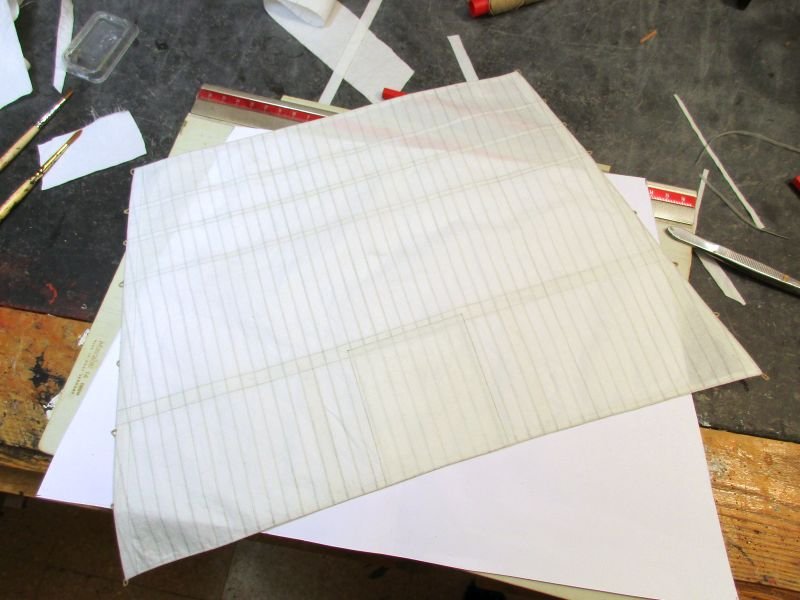
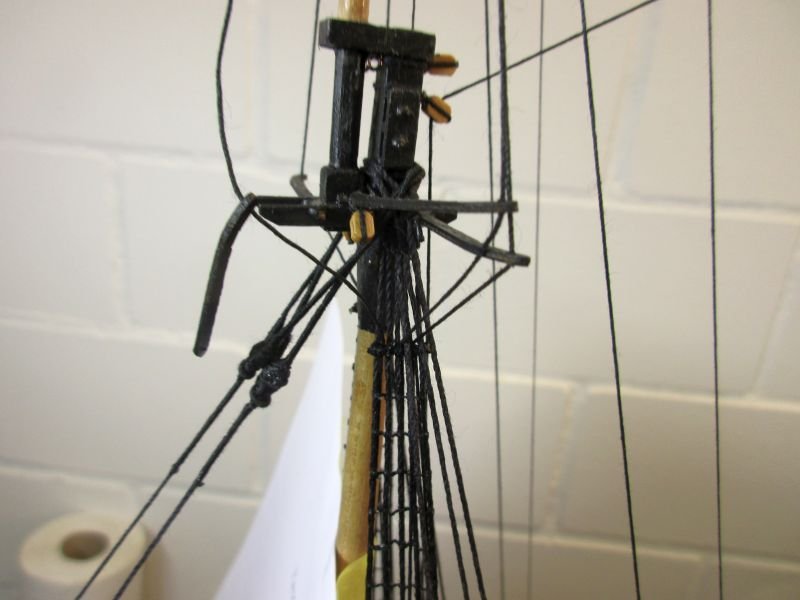
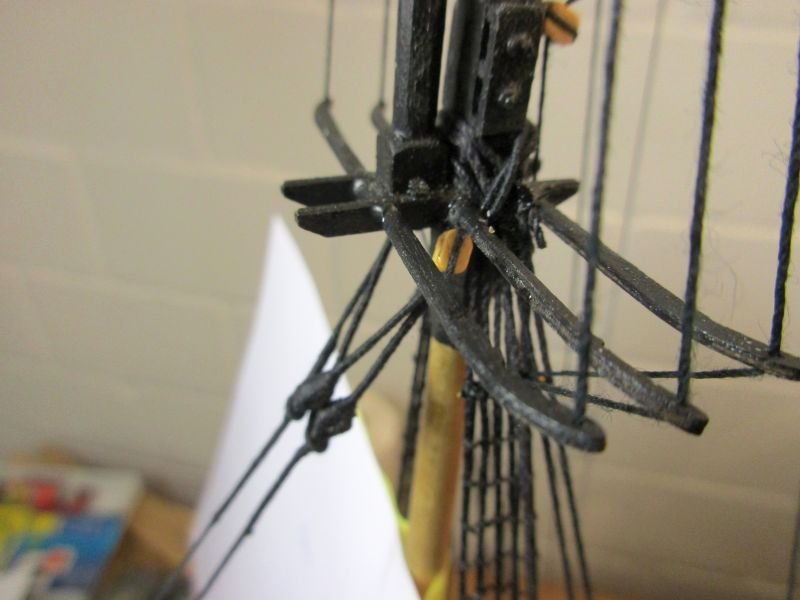
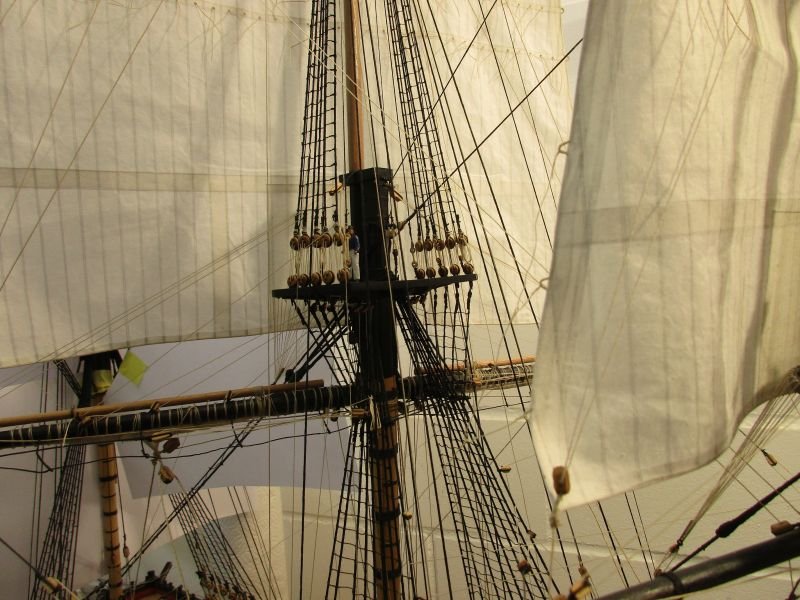

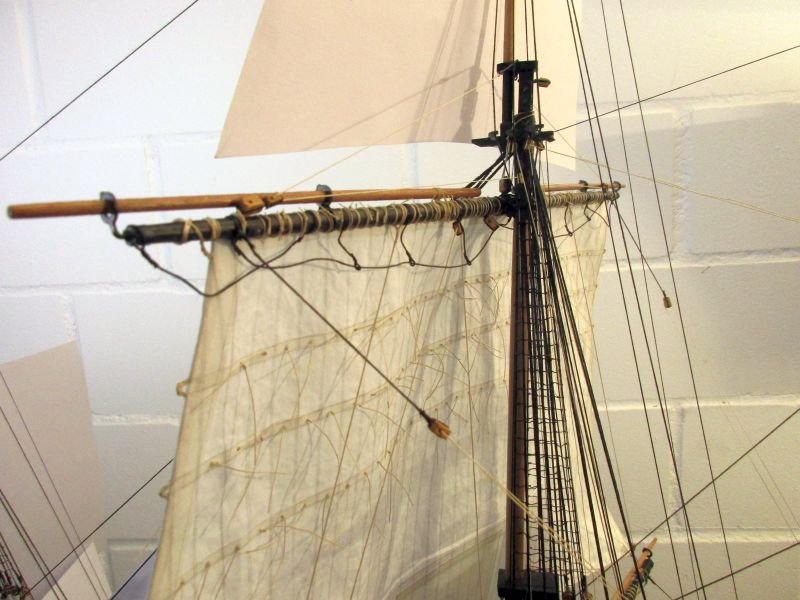
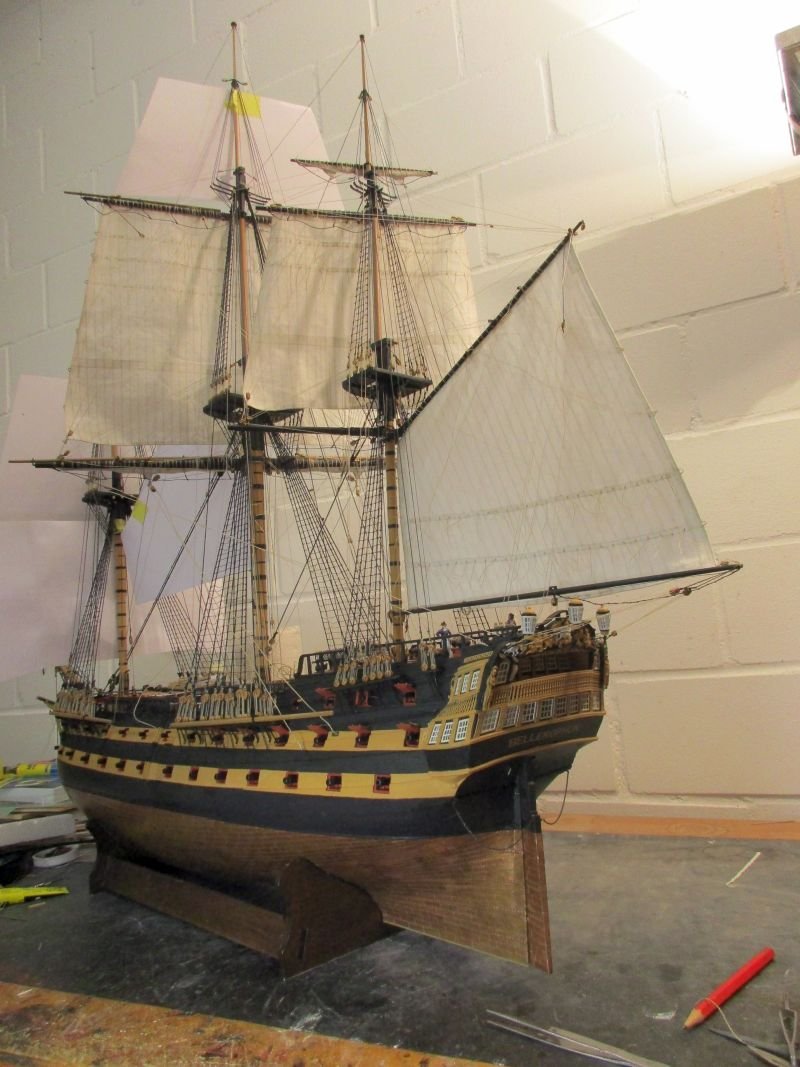
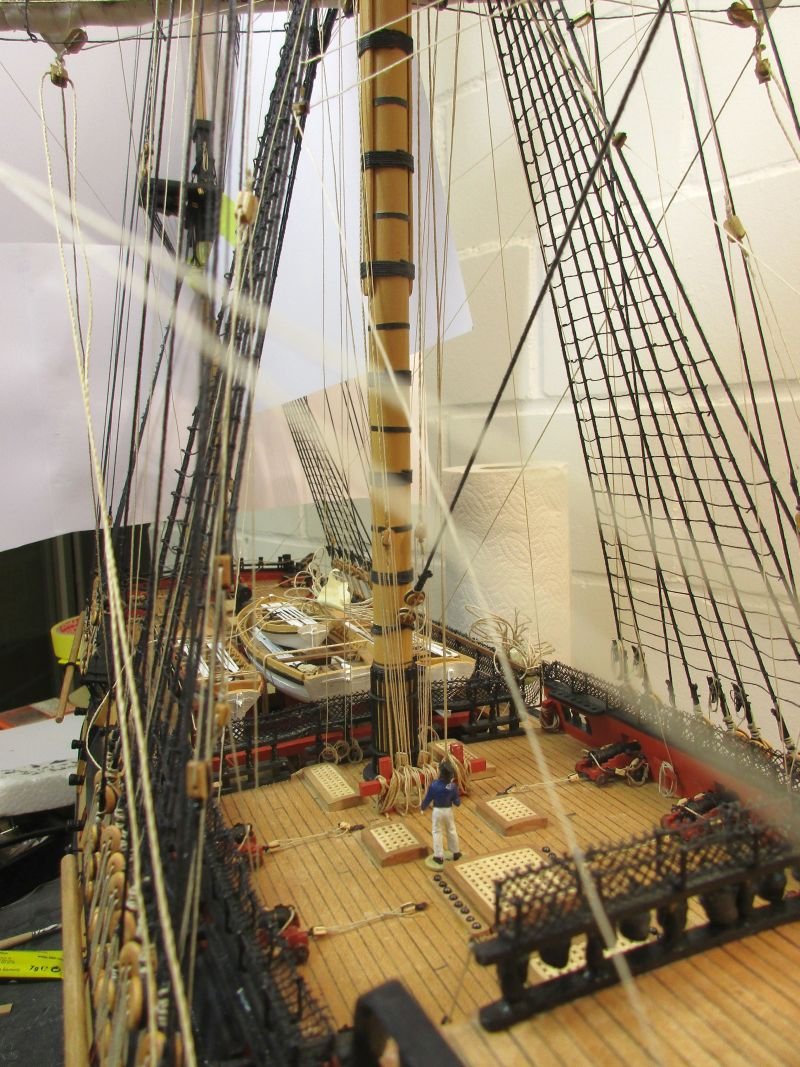

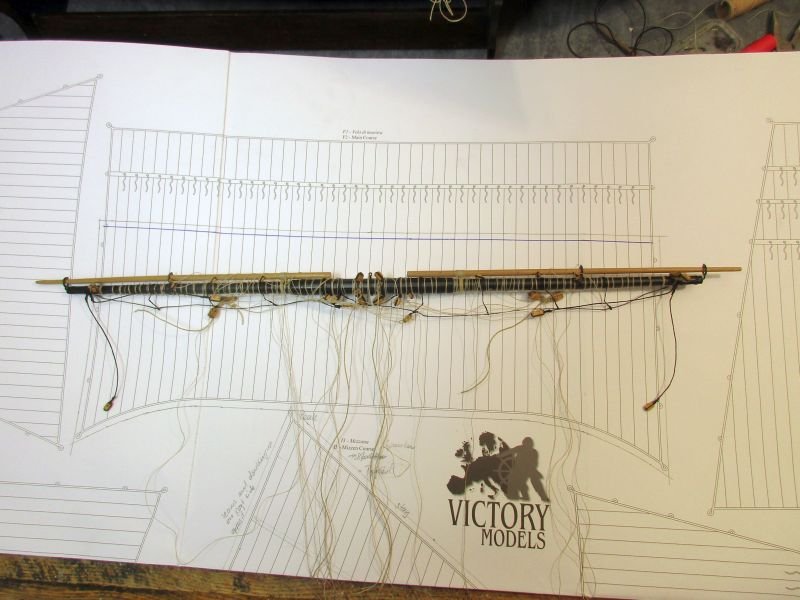
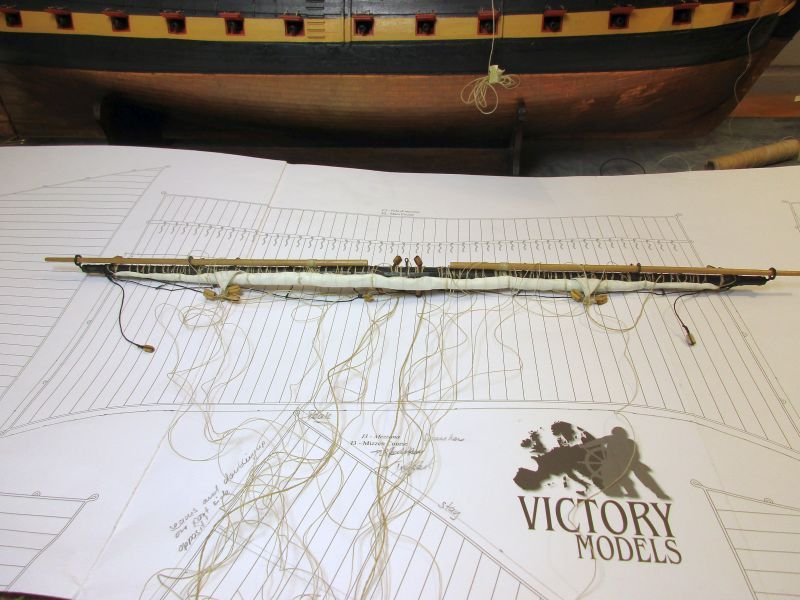
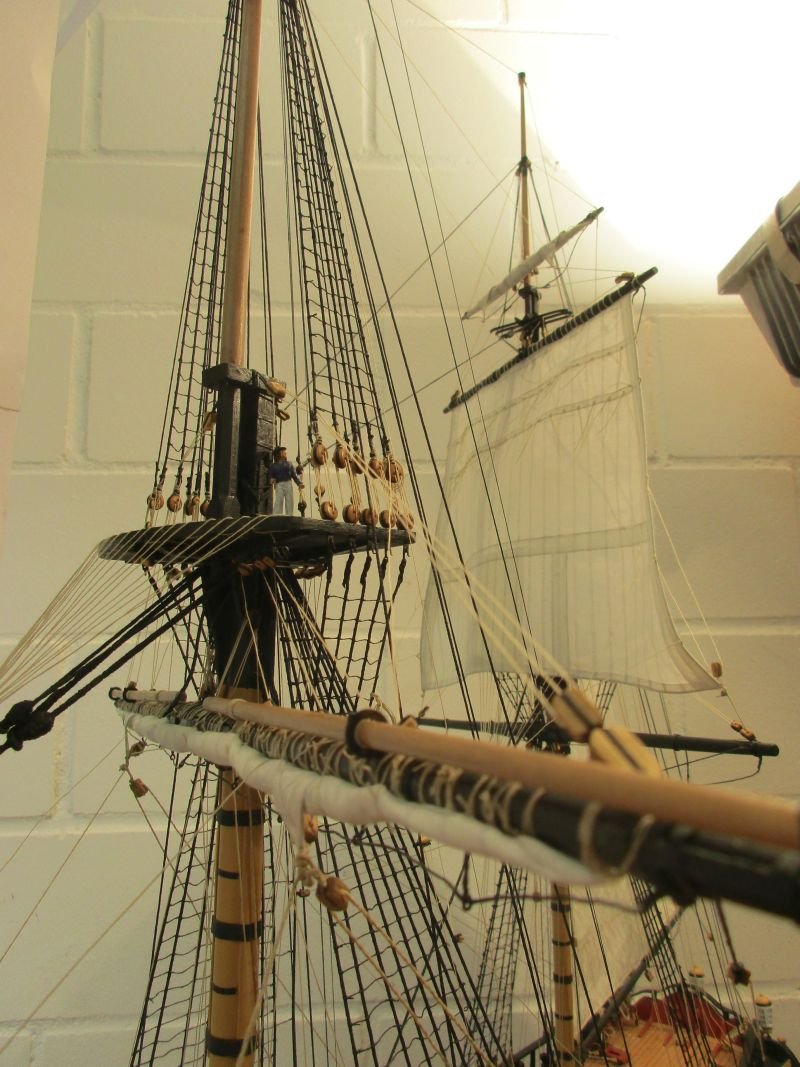
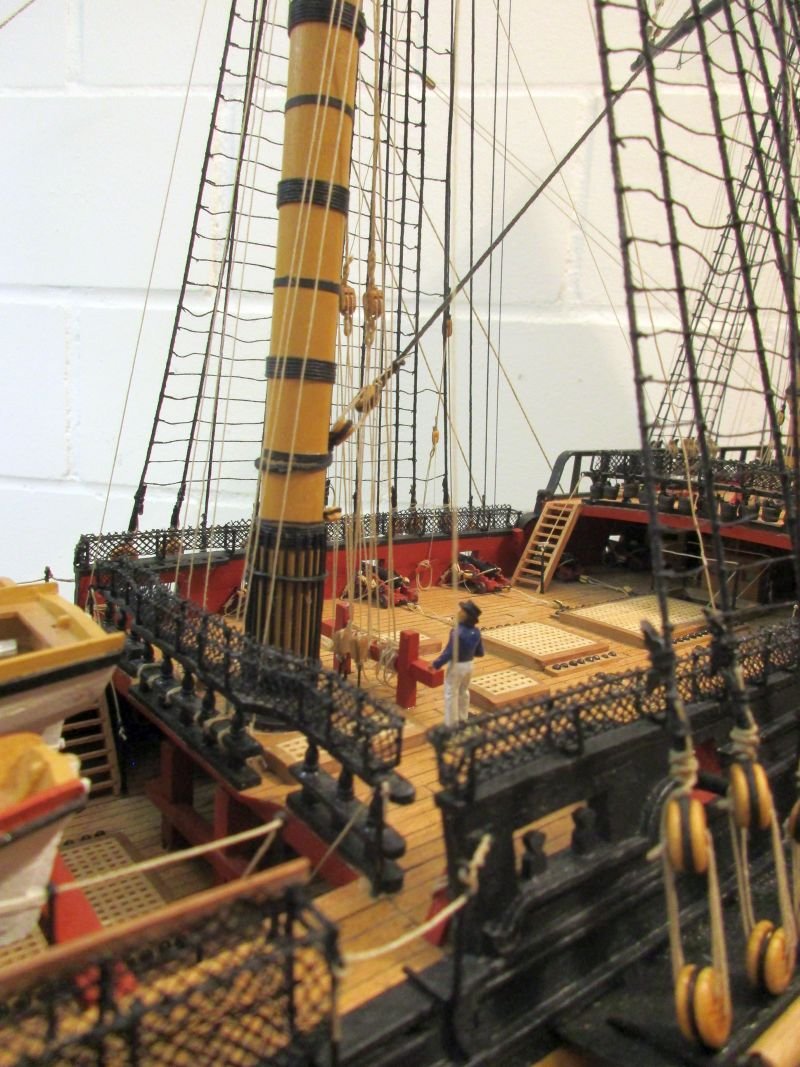
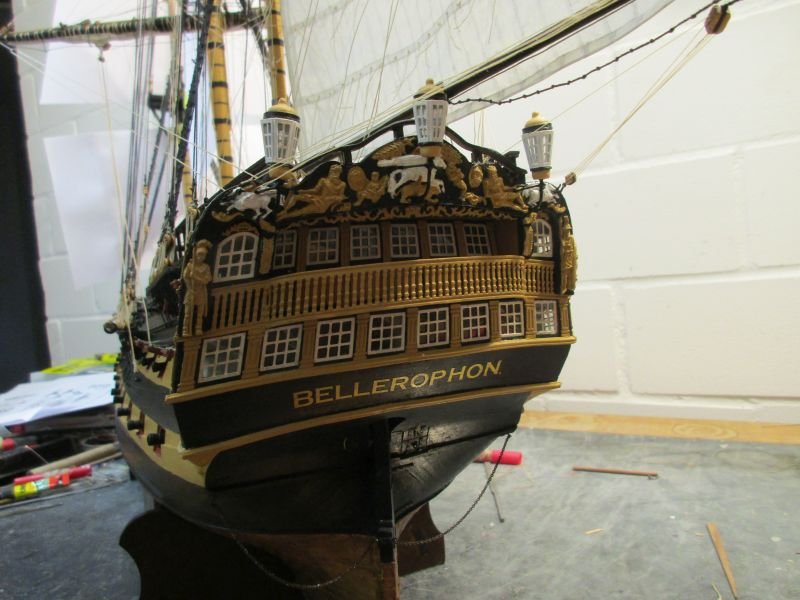
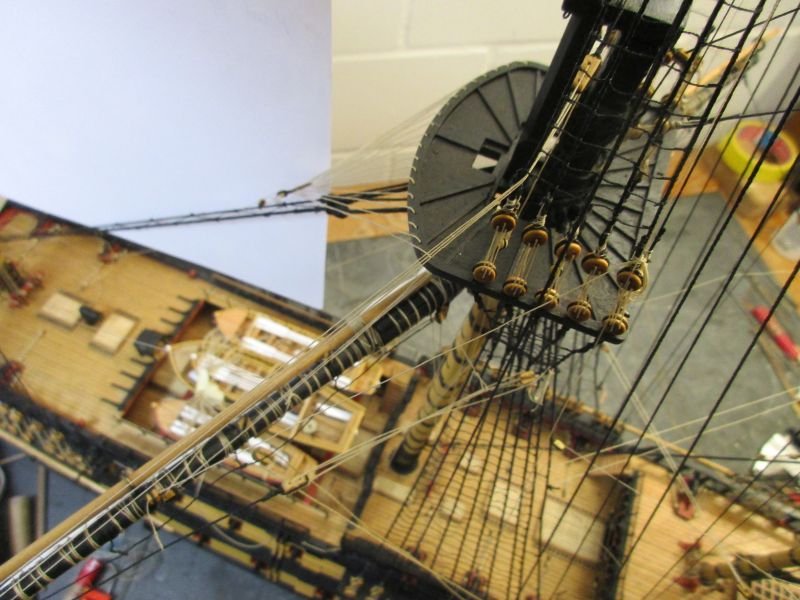
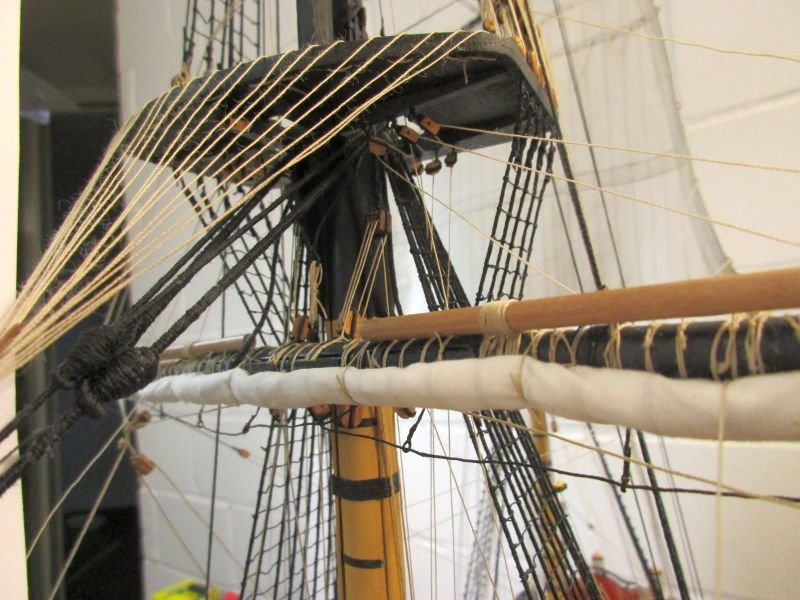
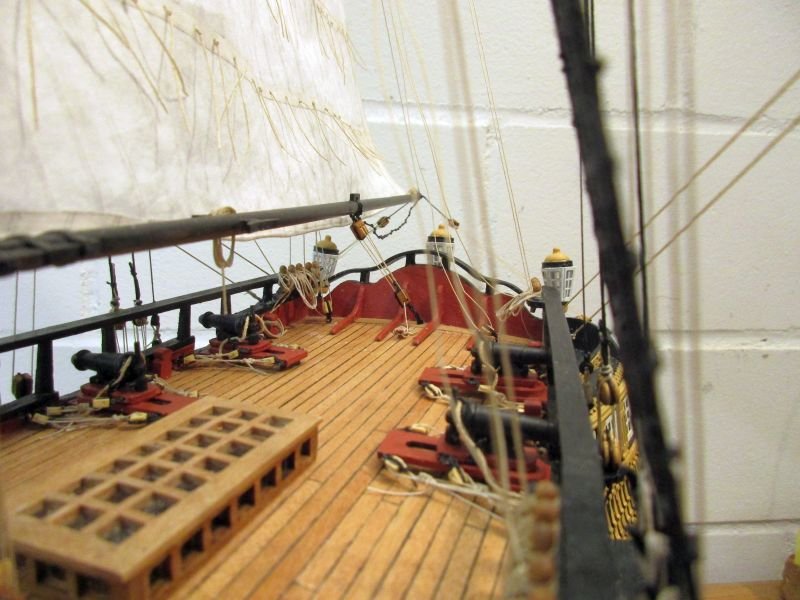

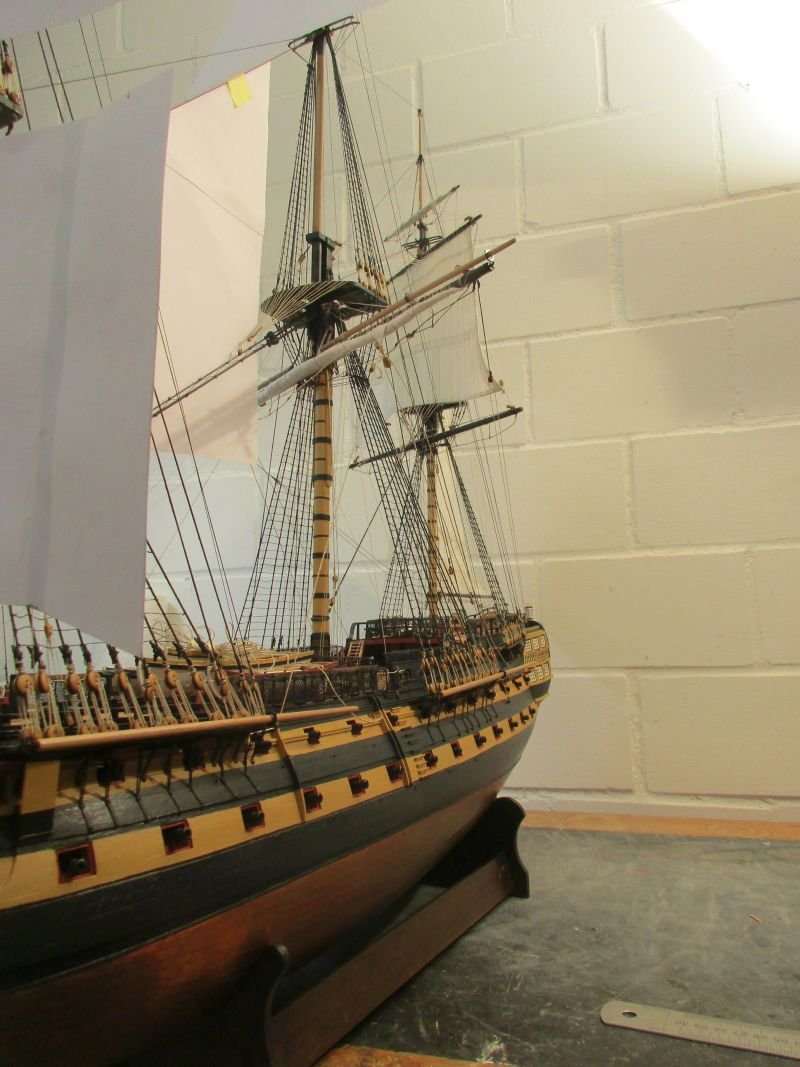
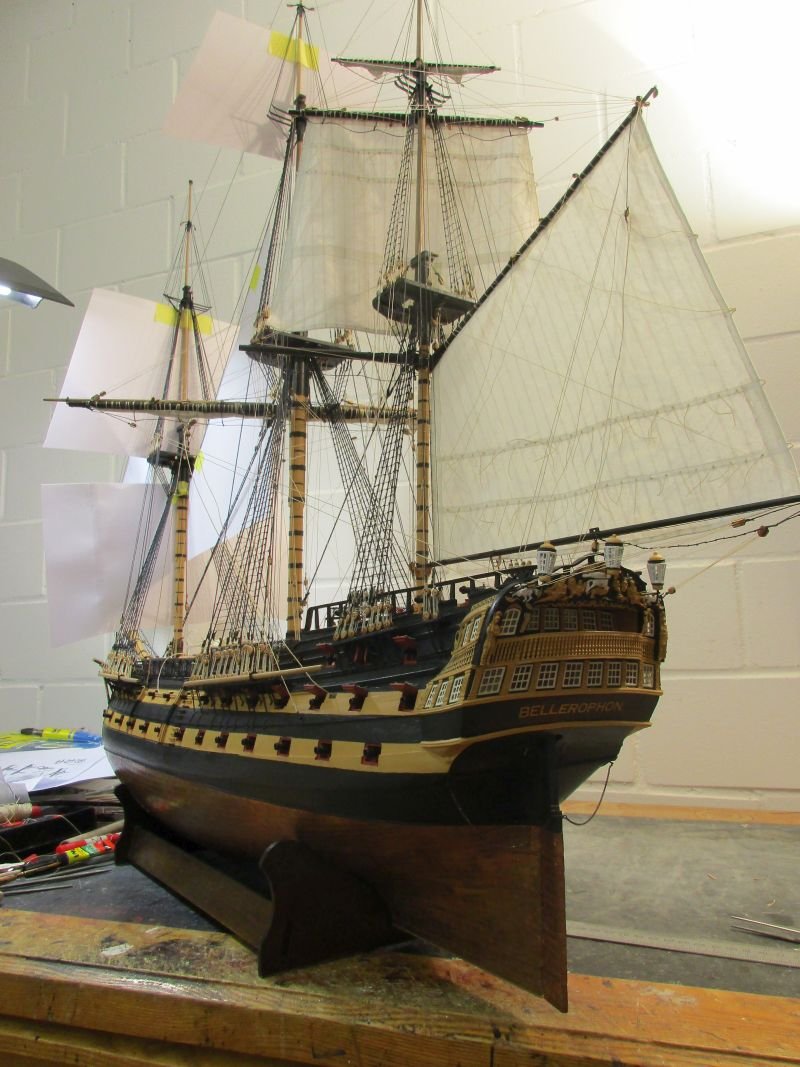
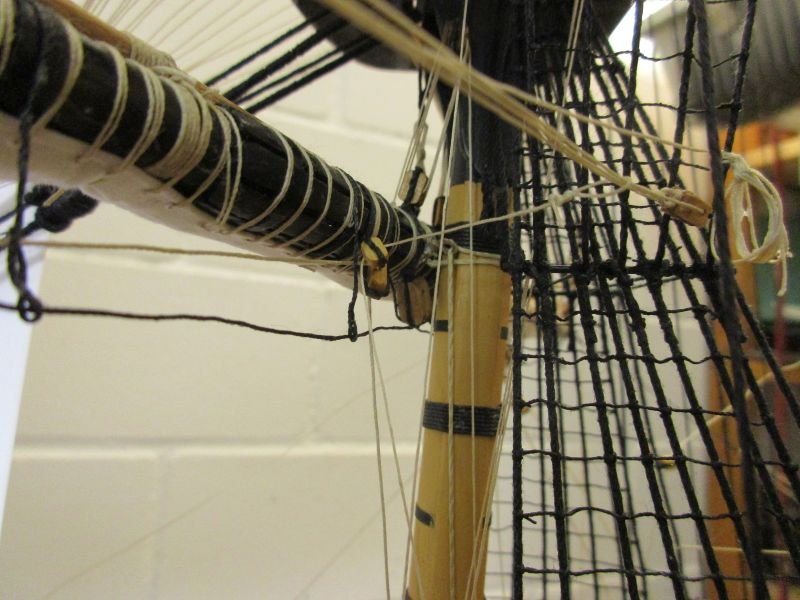

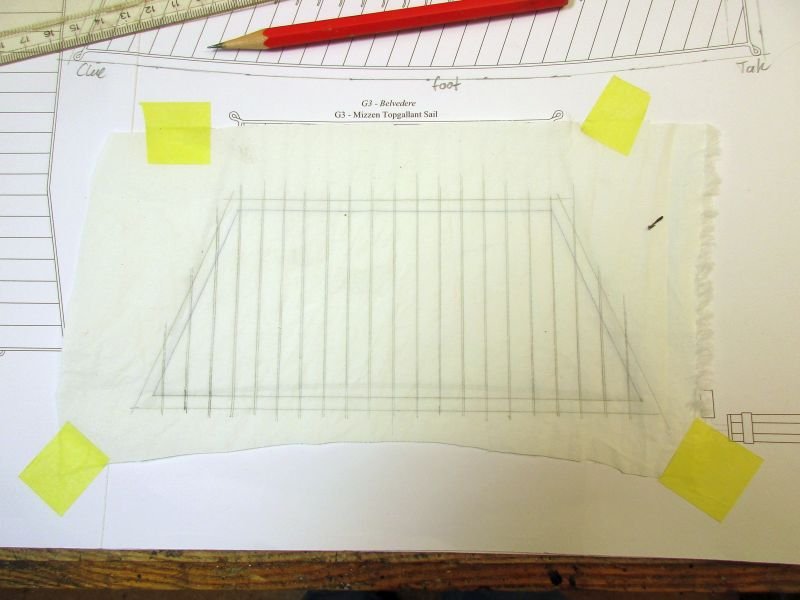
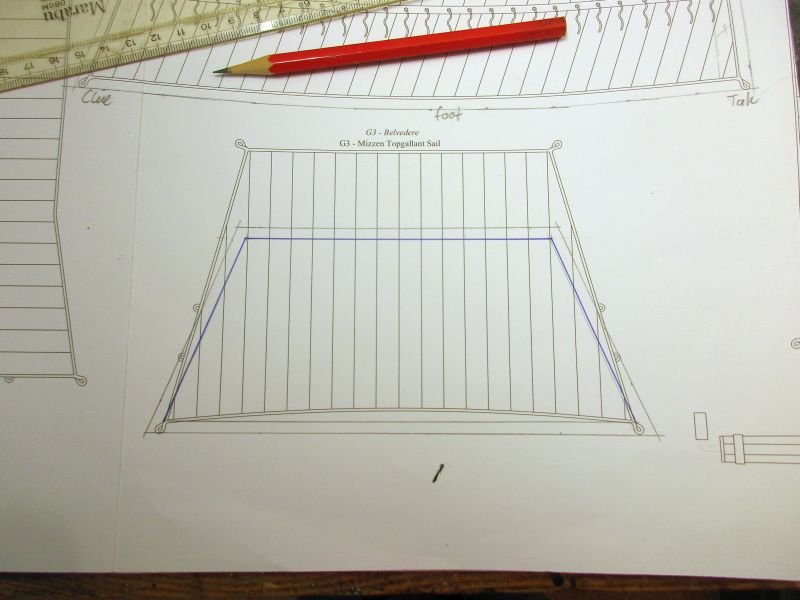

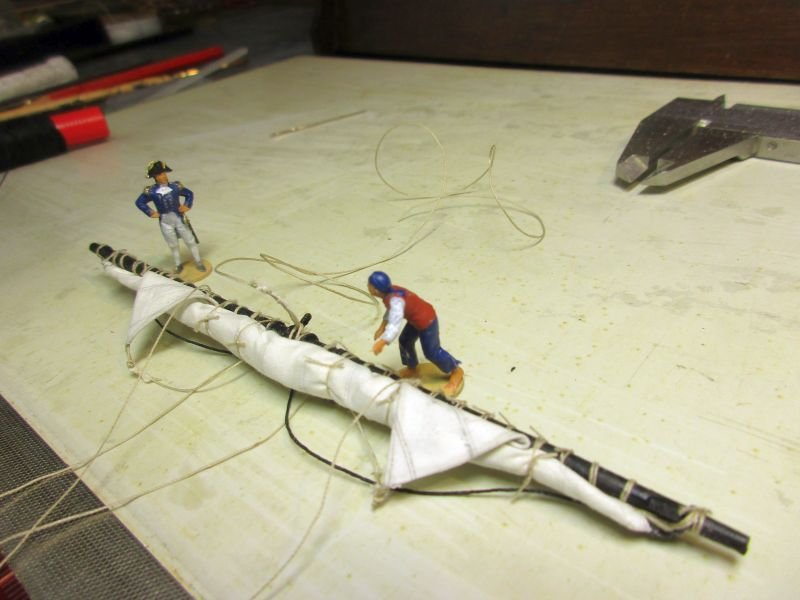
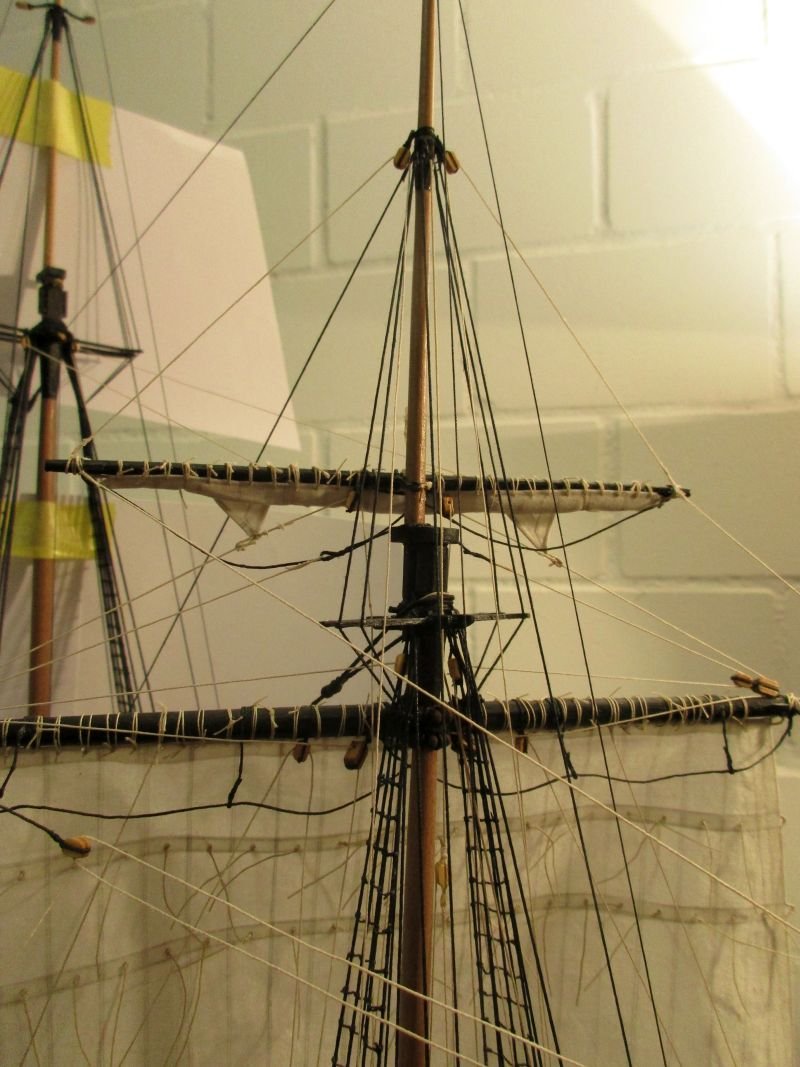
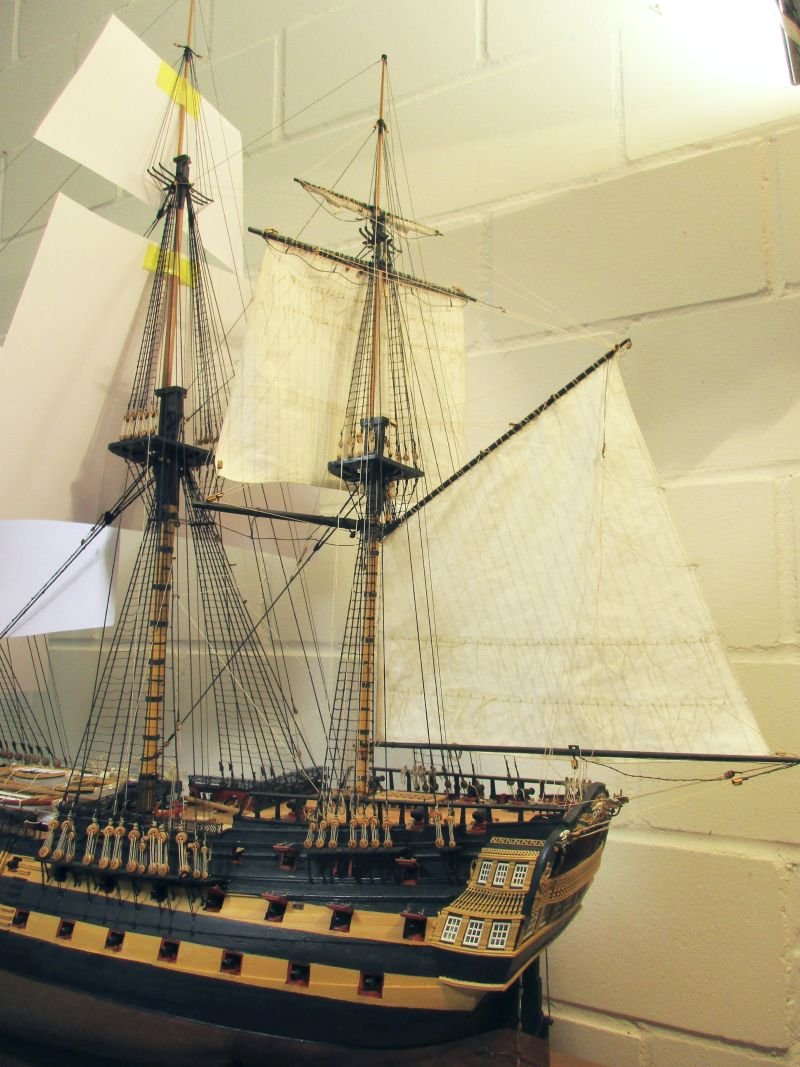
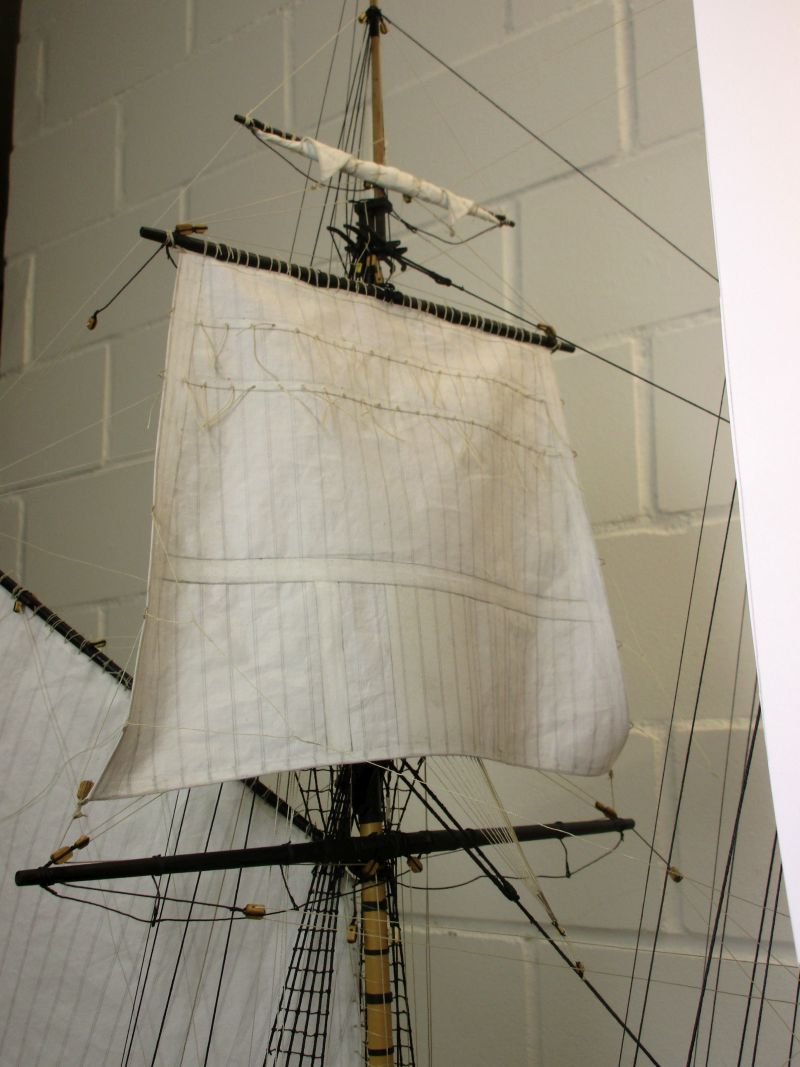
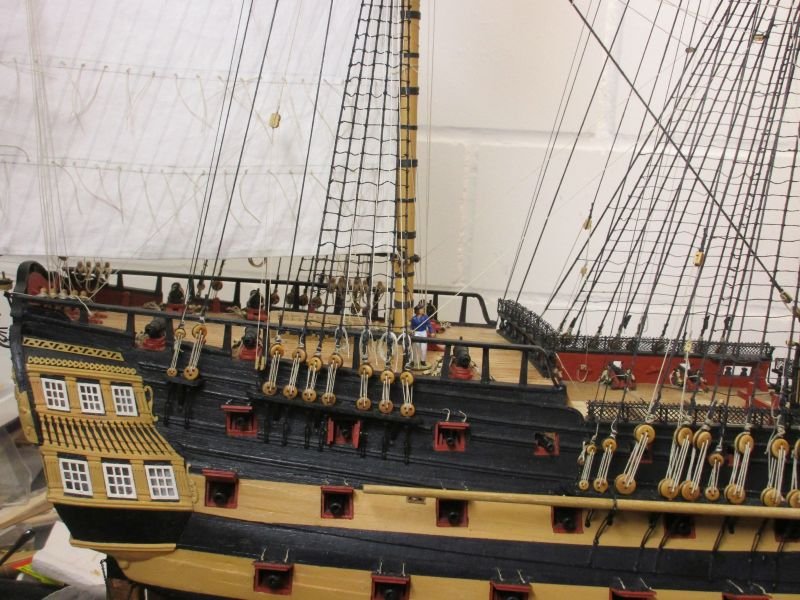

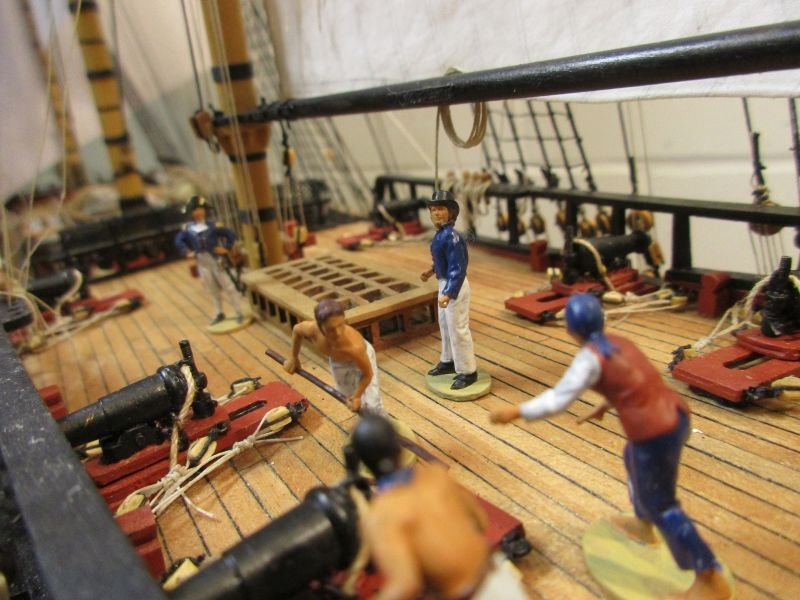
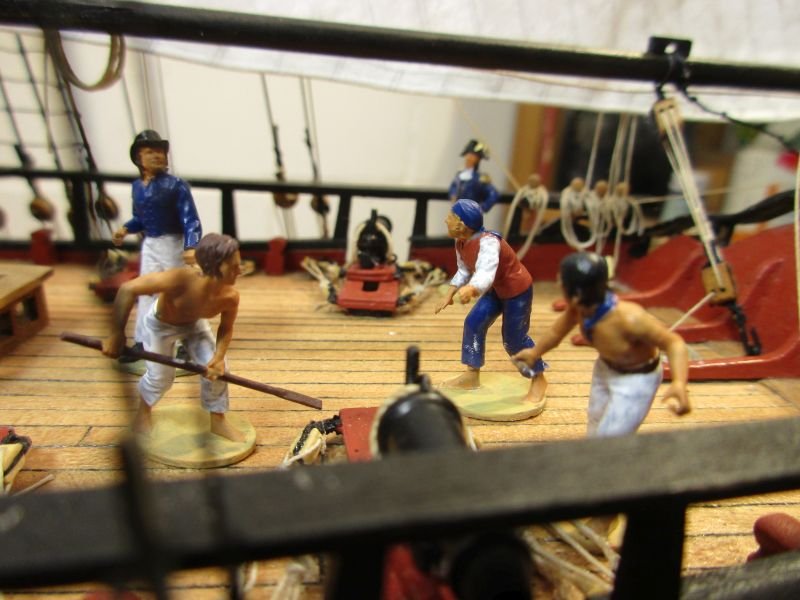
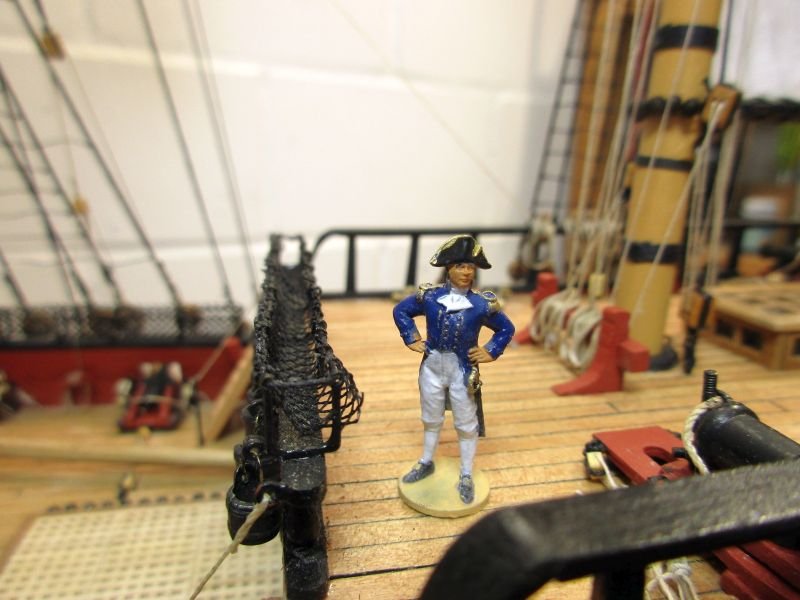
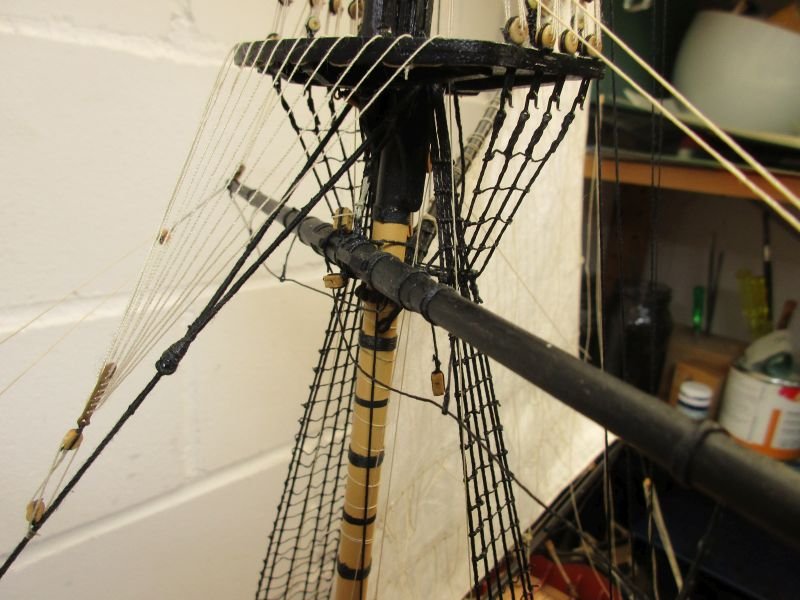
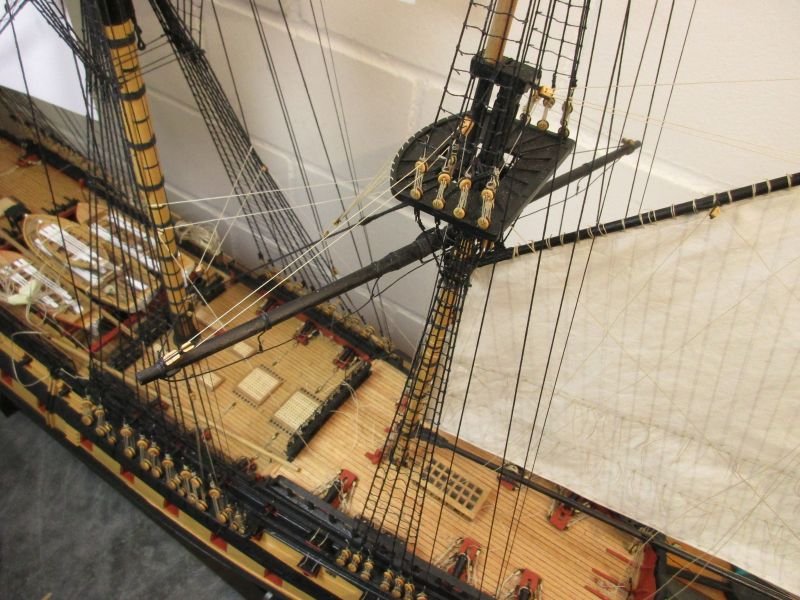
.jpg.2d22e32879d041852c8dddfea1deaabc.jpg)
